The Ritual of Hardship.
On a clear winter day almost ten years ago I was flying over the Aegean Sea on my way to mainland Greece when an impressive steep mountain emerging directly from the sea caught my attention.
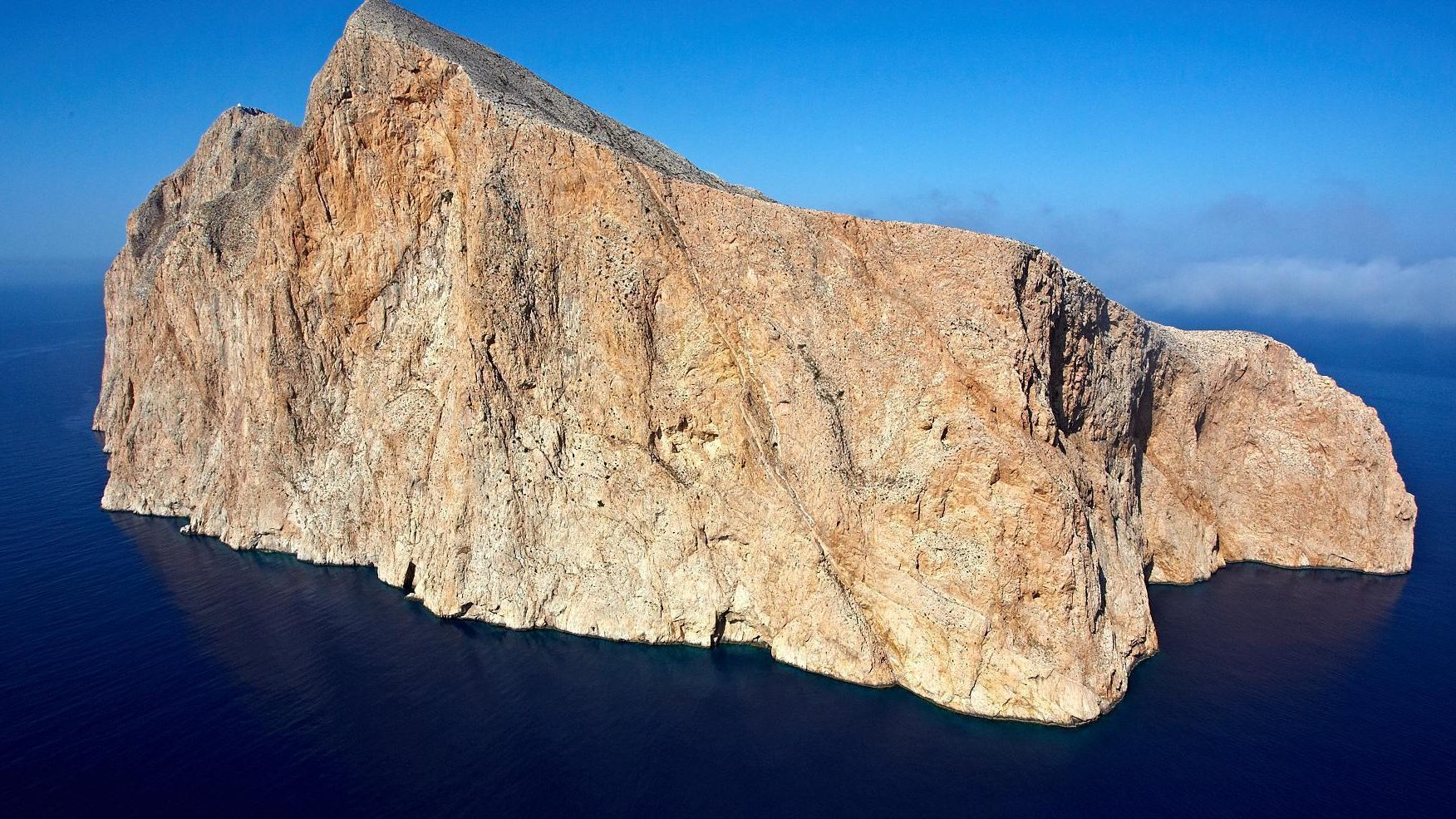
I asked the flight attendant for the name of the island, however, she didn’t know but pointed me to the neighboring cosmopolitan island of Santorini. Once I got back to an internet connection I searched through maps and Anafi came up, an island that I had never heard of before. After a quick search, I found out that the rocky mountain catching my attention was arguably Anafi’s most impressive natural attraction, Mt.Kalamos, a monolithic peak and the second biggest in the Mediterranean after Gibraltar. The next obvious internet search, ‘’rock climbing in Anafi’’, didn’t give any results at the time, so the name just got stored in the back of my head. Years later, in different conversations with my friends Nikos Hadjis and the late Yiannis Torelli, the name Anafi popped up with both of them mentioning their route Halcyon and the endless potential for new routes. After more research, I found more photos of the cliffs and information about the existing routes but then once again Anafi went into my background storage.
It was only last winter when Daniela Banc and I were looking for our spring inter-season holiday destination that we decided to try to put a team together and figure out the logistics in order to make a trip to the island happen. Finding a team turned out to be the easiest part since my brother Andreas Rossidis, his girlfriend Jenny Schauroth and Constantinos Andreou were all up for adventure and we all had similar holiday schedules. While having a strong, super-motivated team to have a good time with while being on a small remote island outside the busy summer season was crucial, the second part of the equation, figuring out the logistics, was still a mystery. Finding accommodation and a way to get to the island was pretty straightforward forward although the ferry timetables were only published last minute since it was the first week of the season for some lines. All the other important logistics arrangements had to wait until we were actually on the island in order to start putting the pieces of the puzzle together.
Dana and I arrived first on the island and after a quick look around the village, we rented a scooter and went for a hike to Mt. Kalamos to check out the approach to the top and get a better understanding of the terrain. At first, walking up to the old monastery through the established trail felt really casual but as we were getting higher the place started to feel unexpectedly wild and remote and we definitely got the first taste of the exposure. After getting to the top of the old monastery we started to look around to see if we could locate any of the walls we had photos of. While we could see some of the walls on the sides we couldn’t see much of the main wall with Nikos’ and Yiannis’ route, so we continued along the ridge over to the neighboring twin peak to see the rest of the walls. After walking down from the summit and towards the east end of the island the impressive SE face of Kalamos came into our sight and we instantly got the shivers. The wall was far more impressive and intimidating than in the photos and the rock quality looked superb from a distance, however, because of the angle we couldn’t really realize the true scale of it. After spending a fair amount of time staring at that wall and taking lots of photos we continued our hike all the way to the east end of the island while checking out all the visible walls.
After a day well spent on Kalamos and with another day before the arrival of the rest of the team, Dana and I decided to get some climbing in and meanwhile check out the quality of the rock. So we went for a short warm-up adventure on a smaller wall opposite of the new monastery where we had a good short introduction climbing day up a nice route on some amazingly featured limestone and marble rock. The next day when Andreas, Jenny and Constantinos arrived, and with a better idea of the terrain we started making a plan. The ideal scenario at this stage would have been to get a boat and have a look at the walls from below, so we started calling and asking around for the boat. Unfortunately, getting a boat wasn’t as straightforward as we thought, and due to the increasing wind and a lot of instabilities in the forecast, the only guy with a suitable boat for our purpose couldn’t take us. So, instead of spending time waiting for the boat, we decided to take our gear to the top of the mountain from where we could all together have a look at the wall and make a plan for the next few days.
With more than 20 kg each on our backs, we started hiking up the mountain. The team was fresh and stoked so the brutal steep hike felt ok and we made it to the top in good time and with the morale still high. After depositing the heavy backpacks on the summit we altogether hiked down to the ledge from where we could see the impressive SE wall of Kalamos. Once this wall came into sight, the laughter and jokes paused, and everyone went quiet and deep in thought for a bit. Since it was already late afternoon we had to get moving. We decided to build an anchor on the top of the wall and use our 100 m static line to abseil down in order to get a better idea of the rock, the steepness and the size of the objective. After building the anchor, we agreed for me to go down the line and so I started abseiling into the void. The upper gray part of the headwall was vertical with lots of features, but soon the angle and color changed and I found myself abseiling a free-hanging line hopefully long enough to reach at least the big ledge we spotted earlier from the observatory spot. Luckily, the rope was just enough to land me on the ledge (which we later named Party Ledge) and after a quick look around it was time to jug up the rope. The wall was steep but quite featured in places so I got excited that at least the part I saw with the right route-finding skills could go and provide some interesting climbing. The same evening we all decided to commit to this face of the mountain and try to put up the first line on it. So it was time to figure out the logistics on how to do it in order to start working on it.
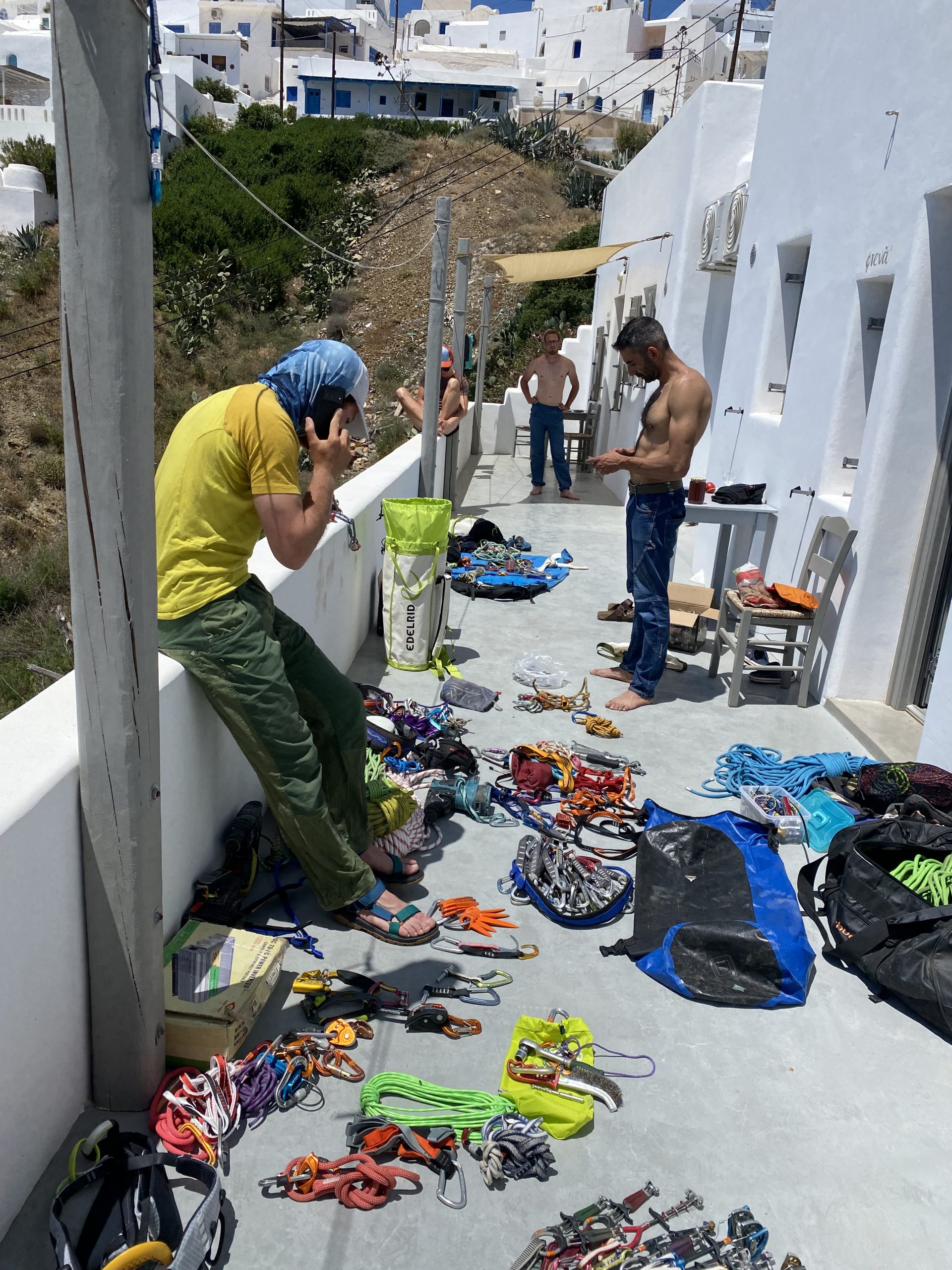
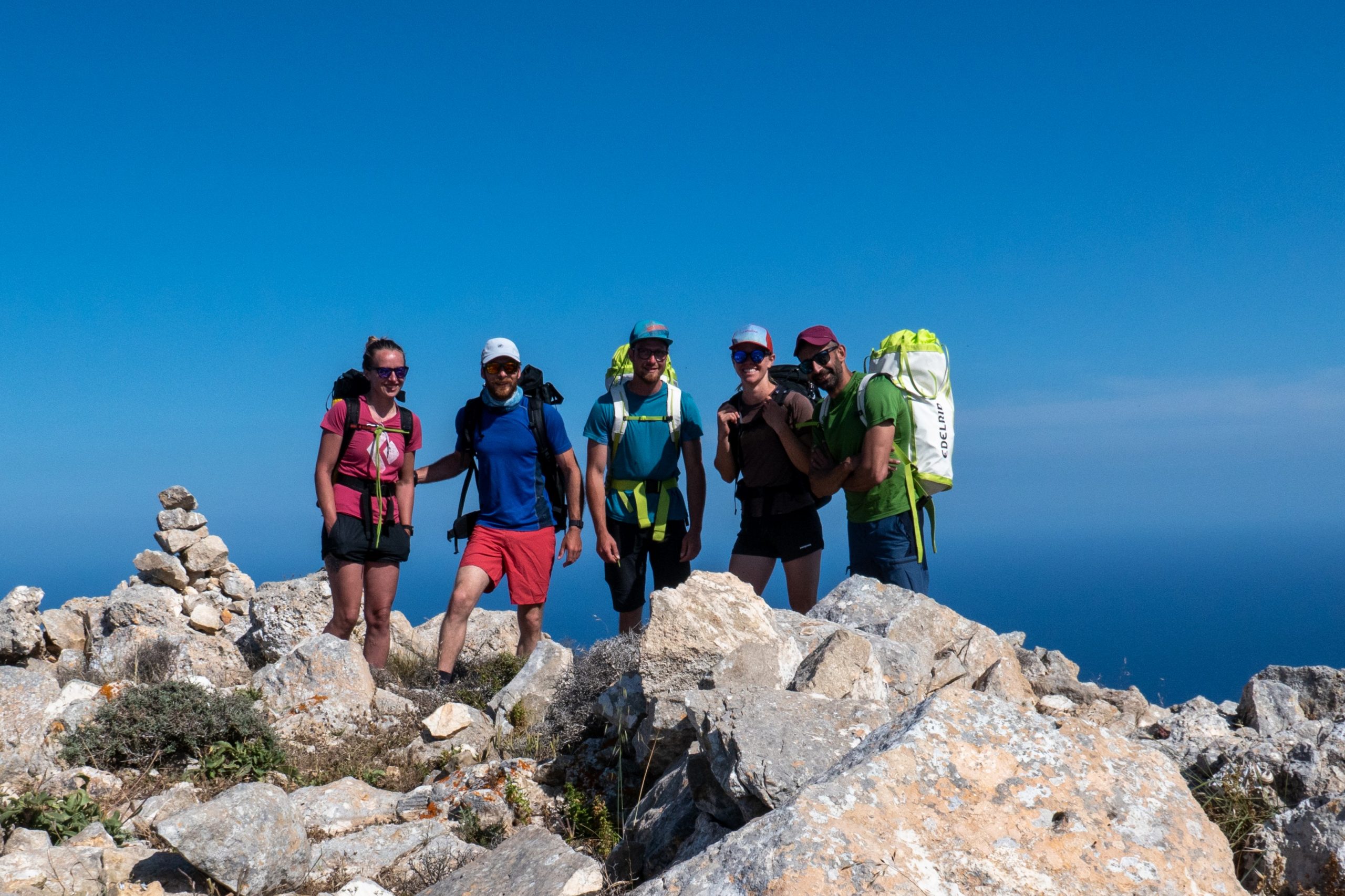
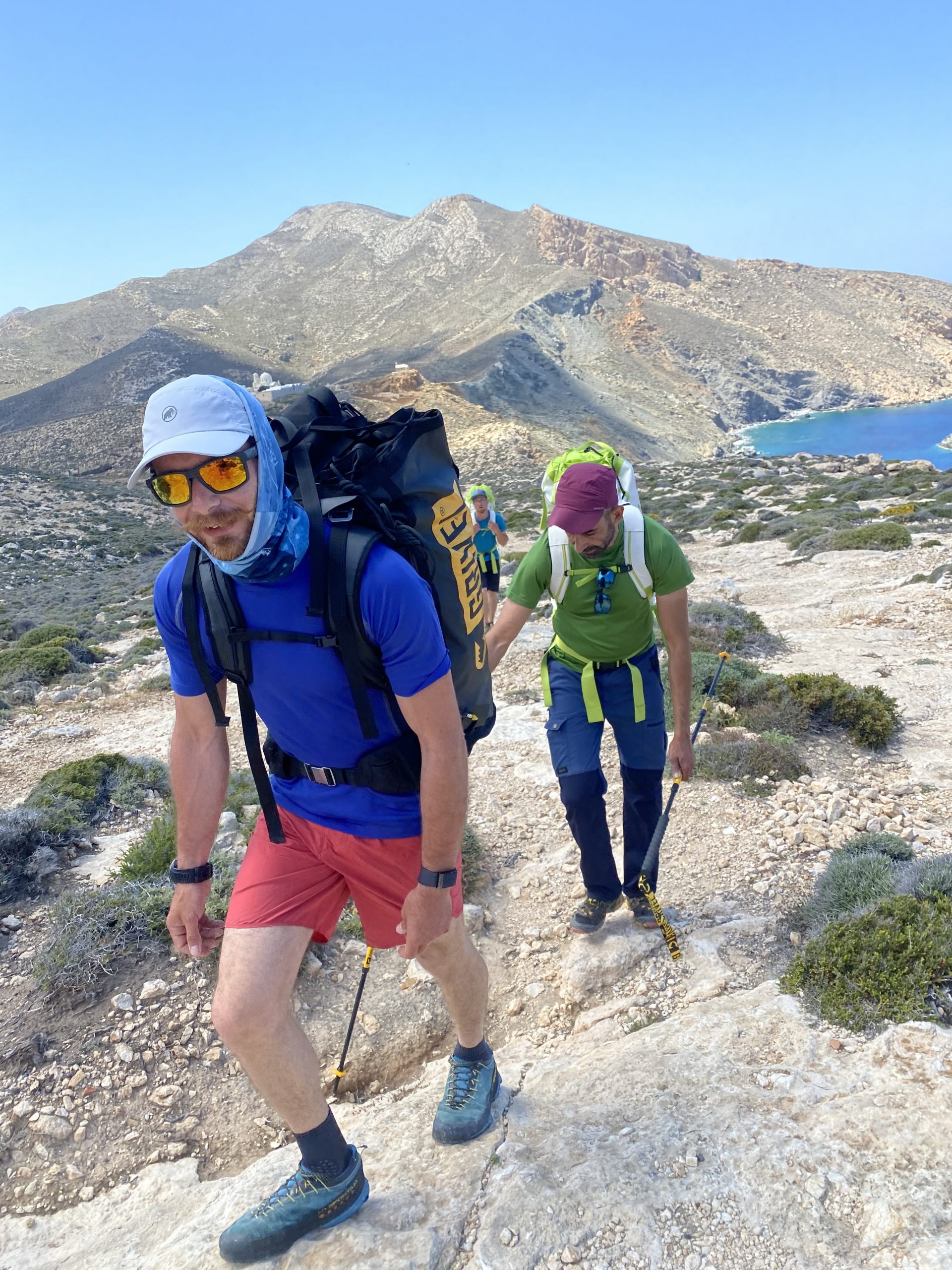
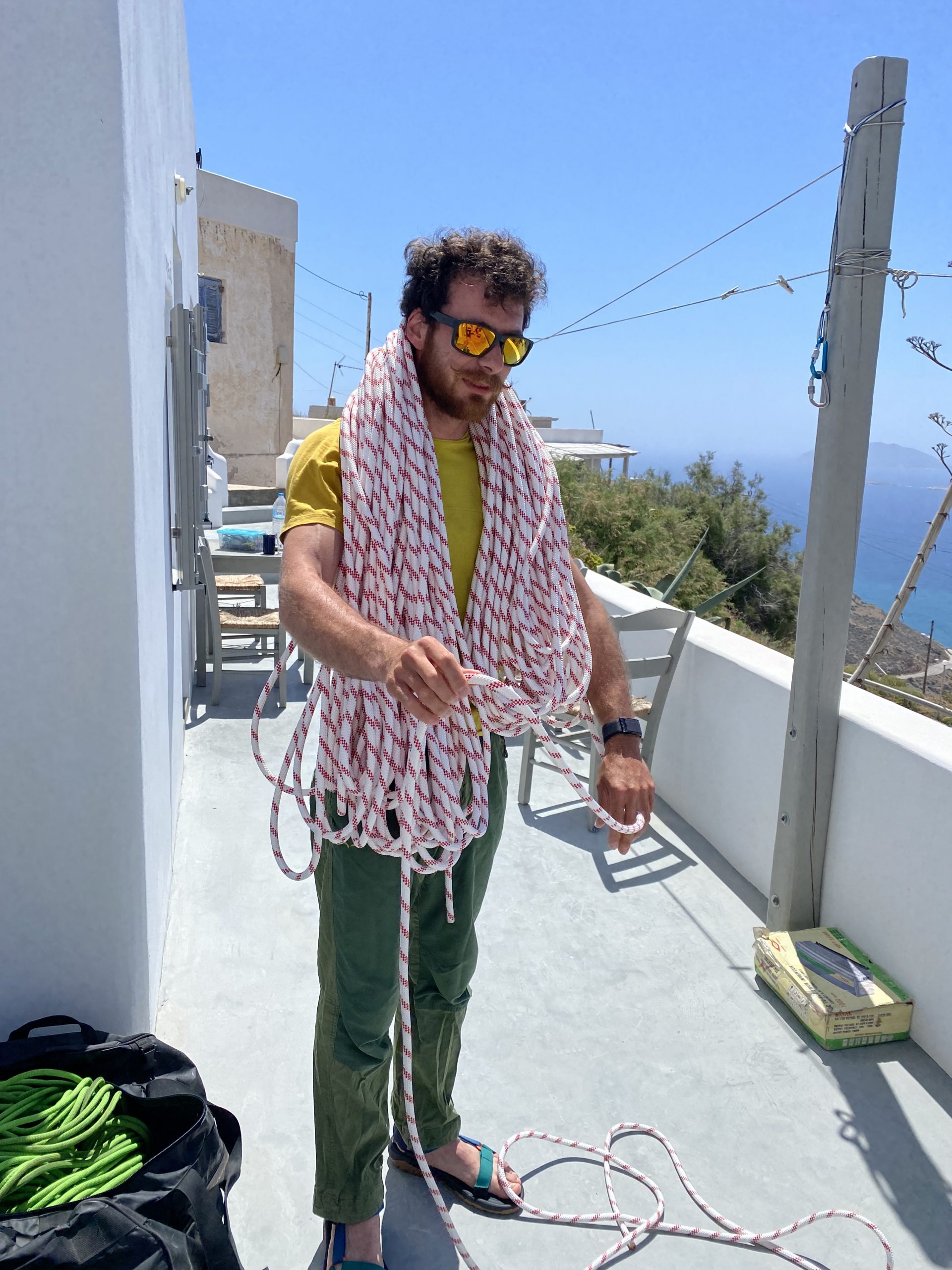
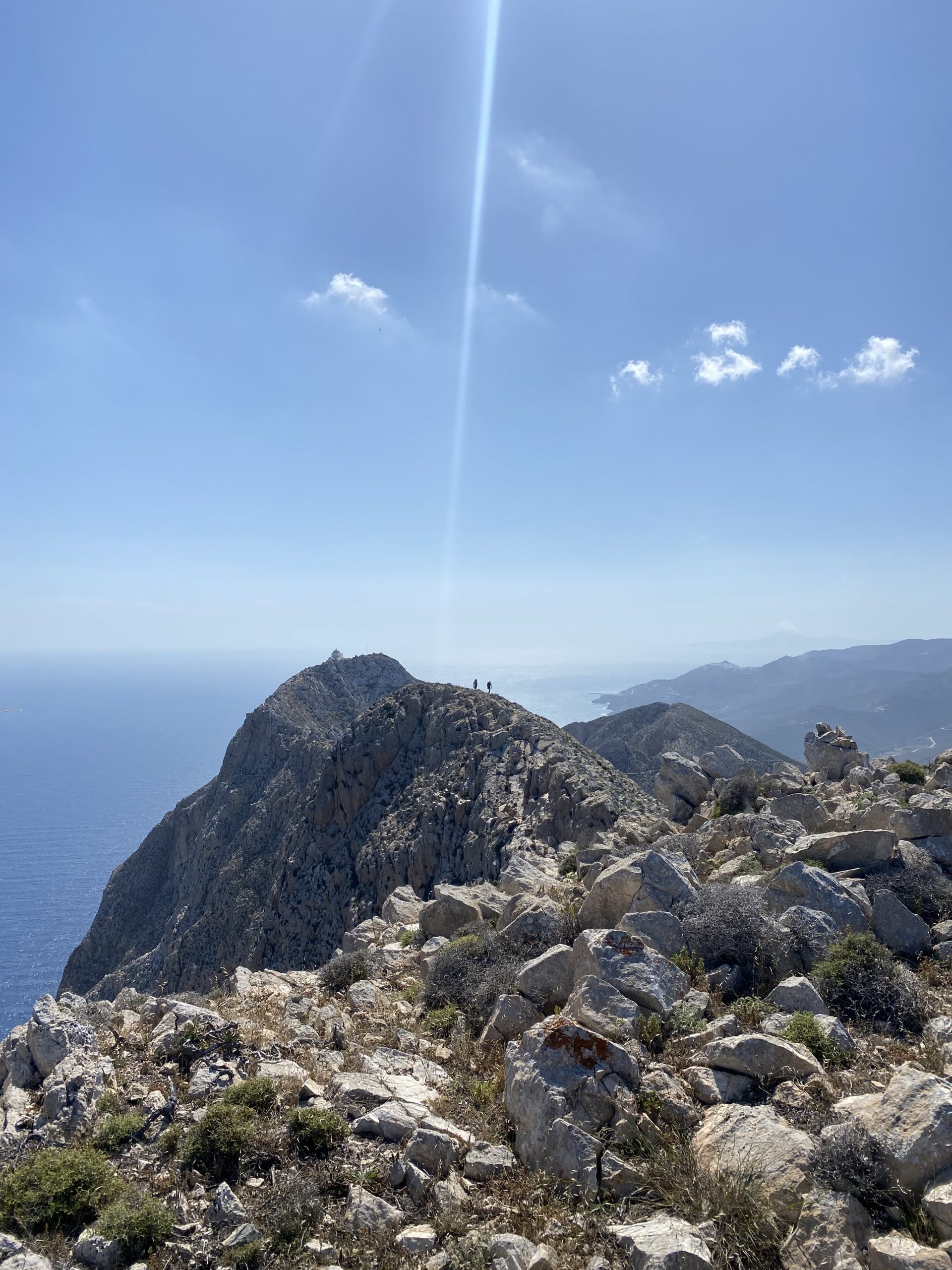
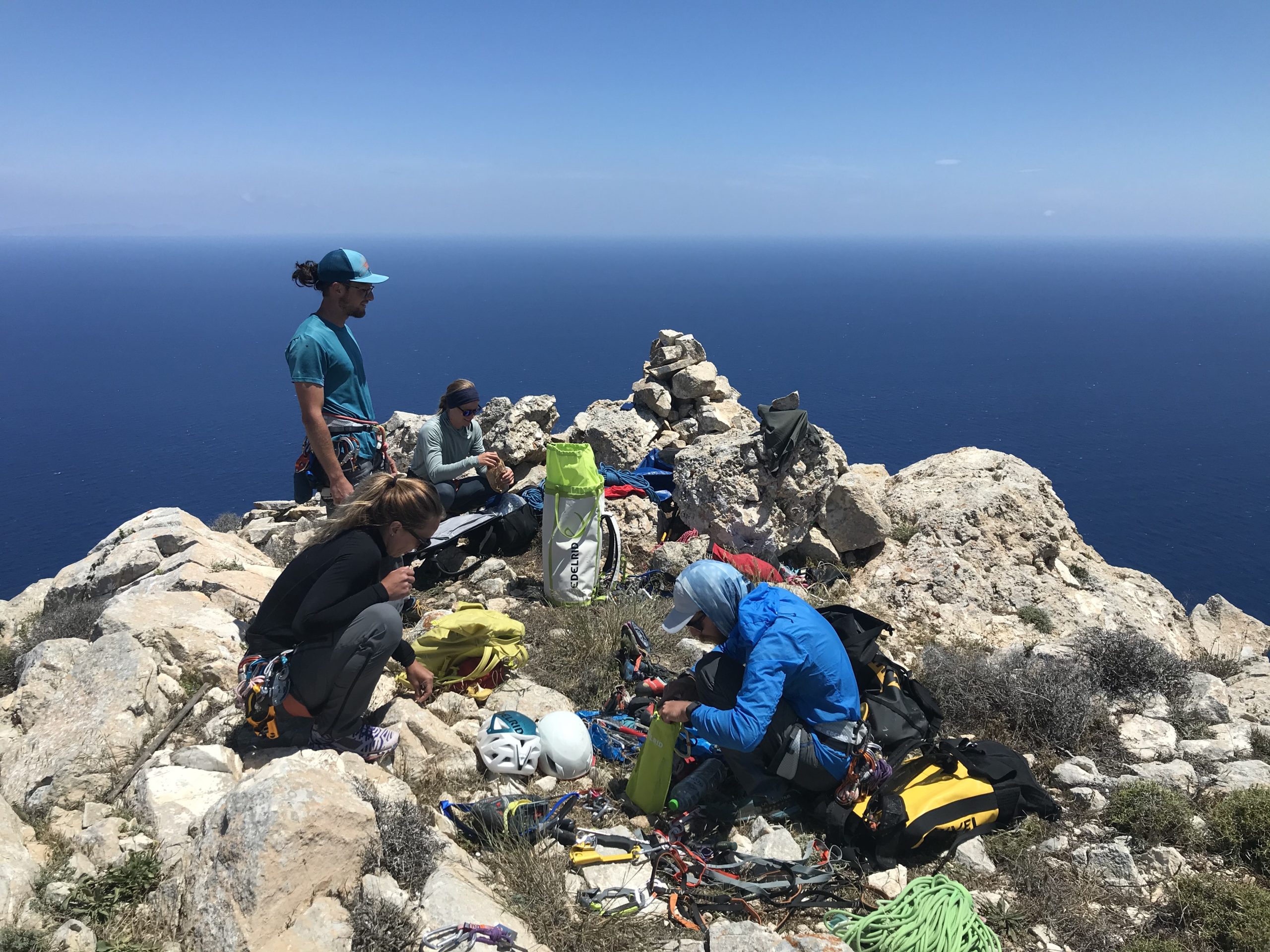
Since the upper headwall was the hardest and most time-consuming part of our chosen line we decided to break it into smaller sections and get straight to work. The plan was to approach from above, abseil down with our 100m static line, start bolting ground up from our lowest point and then climb up the fixed lines, hike out to the trailhead and go back to our accommodation where we could recharge both the drill and our own batteries. The advantages of this tactic were always having an escape route and bolting ground up in order to choose the nicest and most logical line. In addition, with only one part of the team working on the route at a time, the rest of the team was on the observatory ledge from where they could assist with the choice of the line since they had a better view of the whole wall and also could help in case of something going wrong.
It’s important to mention here that although the wall is on a Greek island, in the middle of Aegean, unfortunately getting a rescue was less likely than getting one on a remote Himalayan peak, so having a bigger team was nice. The disadvantage of our plan was that after working all day on the route we still had to jug up a long way to get out of the wall and then hike all the way out, something that we ended up doing in the dark with the head torches almost every time. Finally, we spend 4 non-consecutive days equipping the 10 pitches of the headwall.
Luckily one of the days in between we managed to get a boat ride to the base of the wall from where we could actually see it from below for the first time but also figure out the approach from the boat to the route. At that stage, with all the headwall equipped and the beginning of the route from the boat sorted, we needed to figure out what to do with the lower-angle terrain below the headwall. The terrain there is relatively steep in places but it has lots of vegetated ledges in between. Hauling gear on that part wasn’t an option and climbing with all the gear on our backs didn’t justify the purpose either so we decided to equip the belays and place bolts wherever we thought necessary while abseiling from above and getting out to the boat. The last day of working on the route was really important since everyone had to get on the route and complete a task in order to finish equipping it, clean all the fixed lines and stash some food and water for our climbing attempt.
On this fifth day of working on the route, we started early with heavy backpacks once again. Once at the top of the route we rearranged gear, sorted out food and water stashes for the wall for our climbing attempt, and then everyone started with their task. Everyone got down to the Party ledge, where we split into two groups. Constantinos and Jenny, stripped all the fixed lines of the top part of the headwall while jugging up. They then took everything from the top and went down to the port from where they met with our boat guy in order to come and pick us up from the bottom of the route. Meanwhile, Andreas, Dana, and I stripped the fixed lines on the bottom part of the headwall, stashed our haul bags at the base of it, and then we started abseiling down and equipping the lower part of the climb. The plan worked perfectly and by the time we were at the bottom of the route the boat arrived, picked us up and we went straight back to our accommodation for a well-deserved dinner and a few celebratory beers.
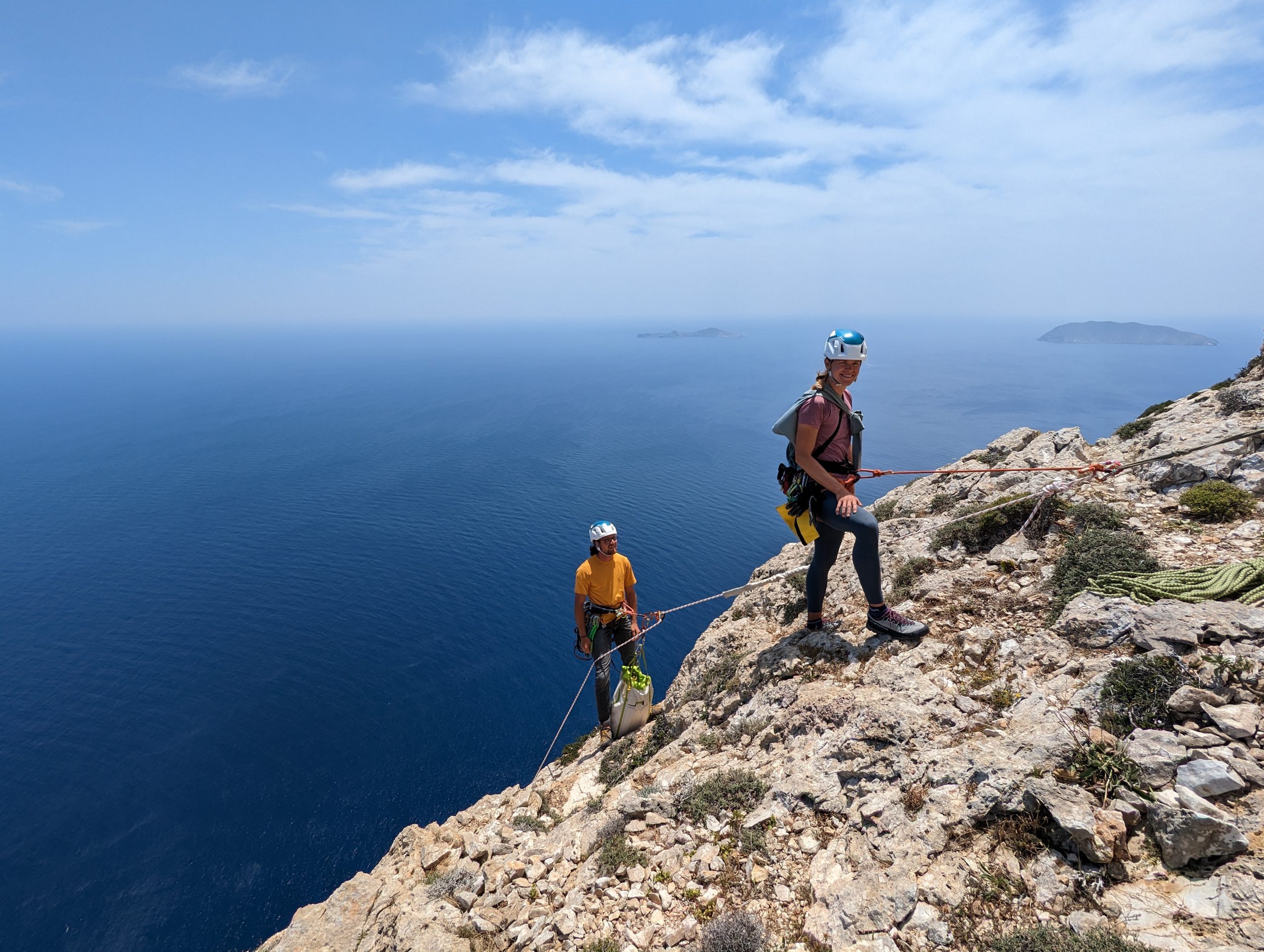
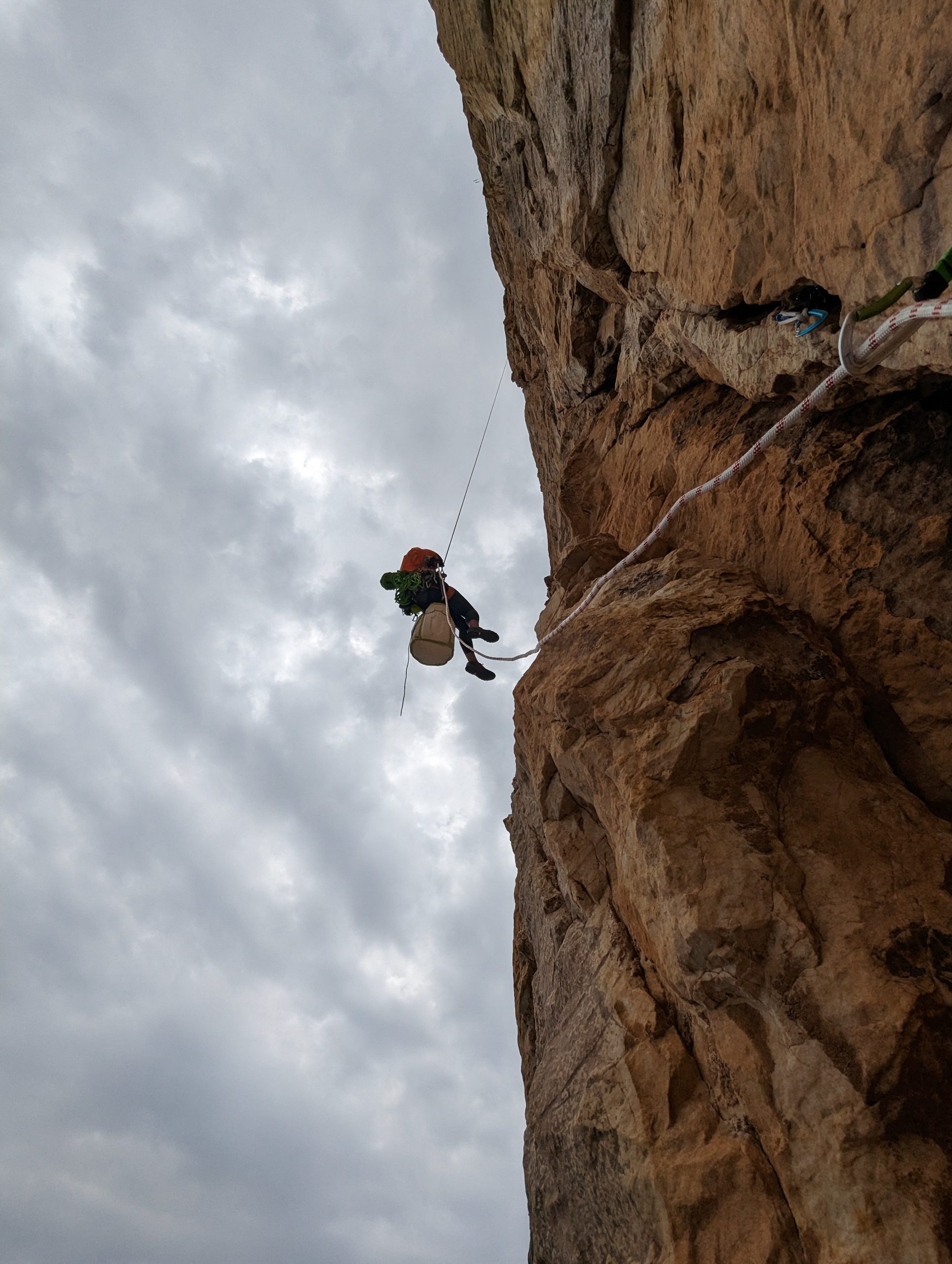
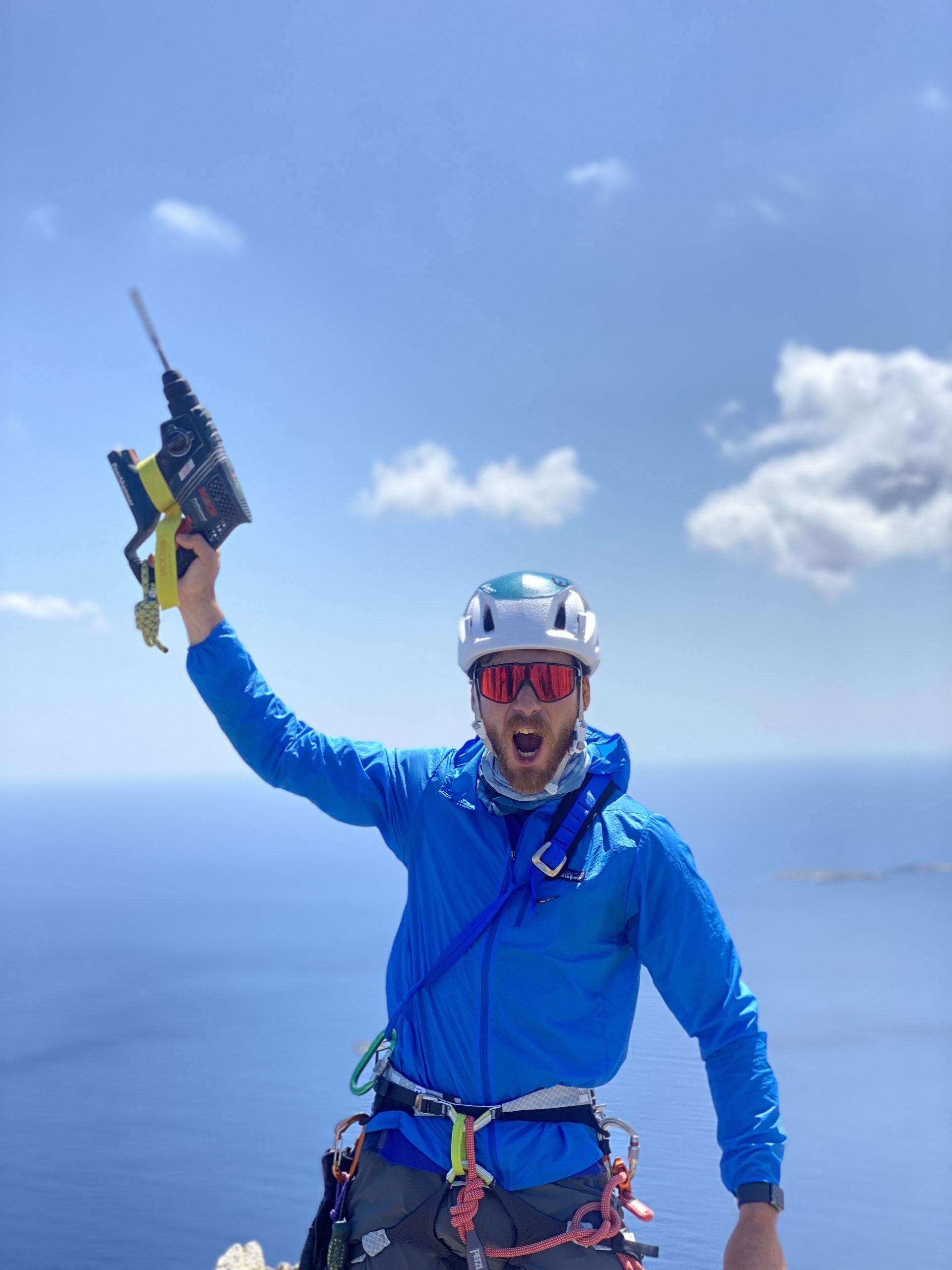
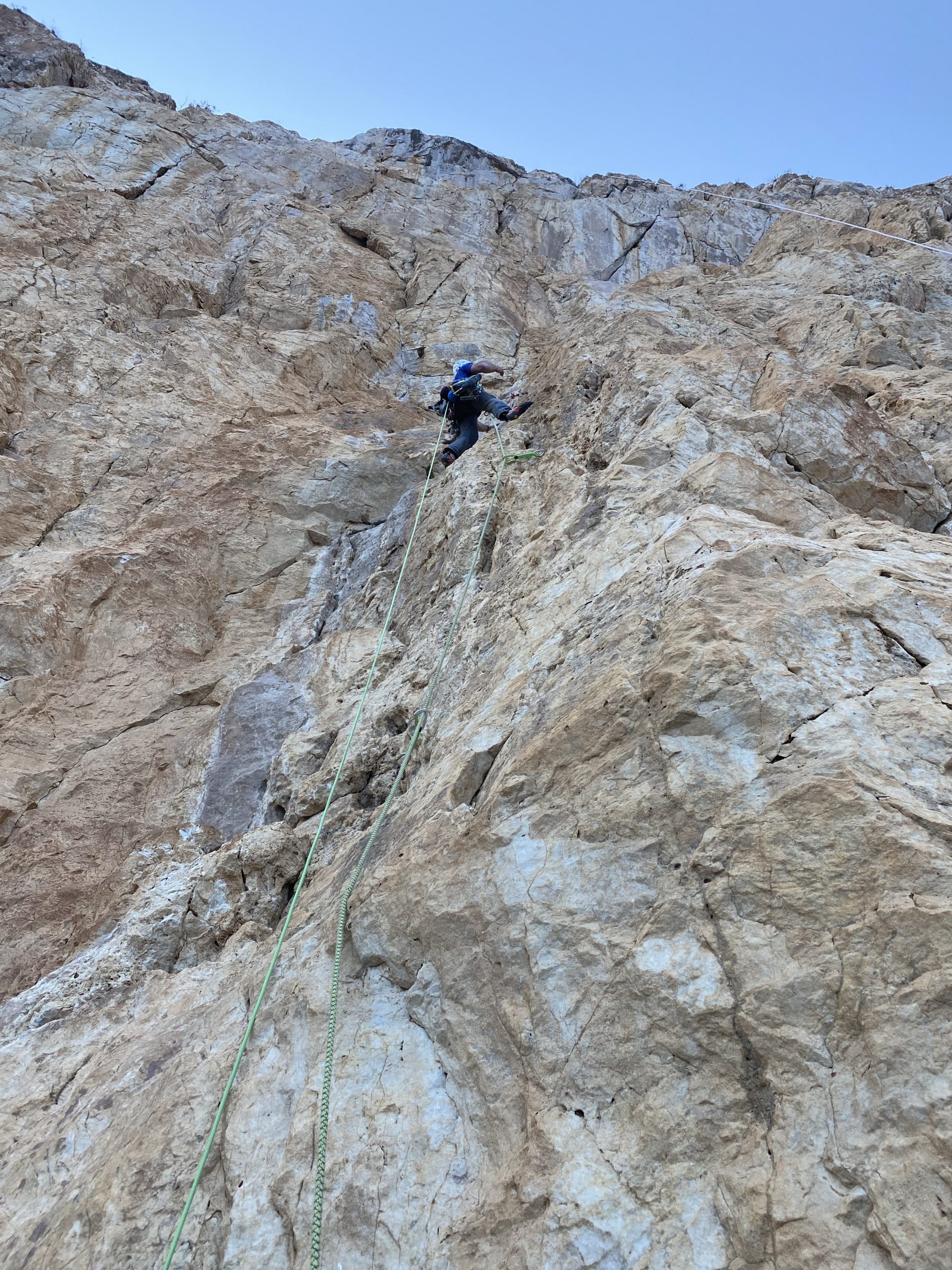
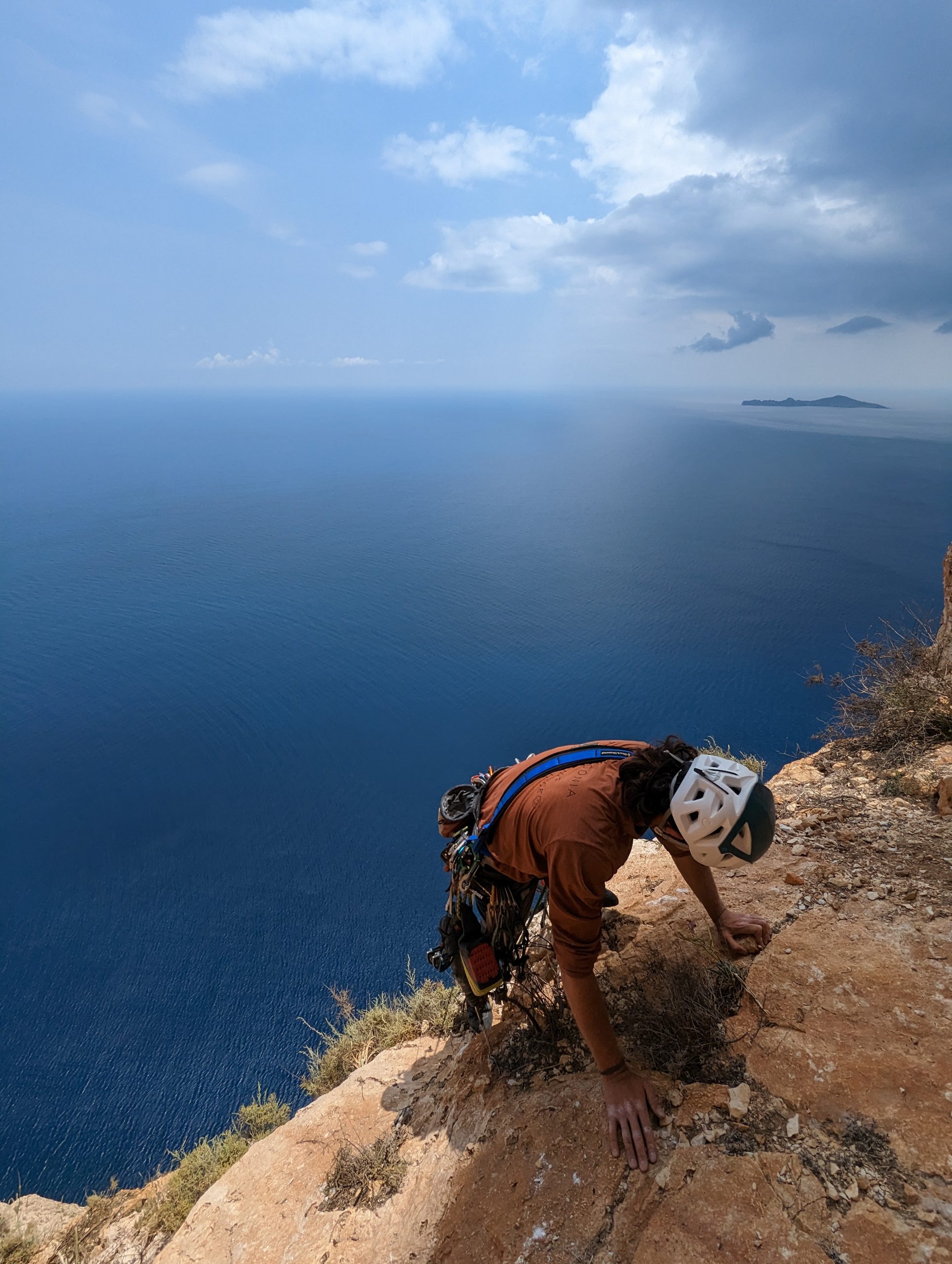
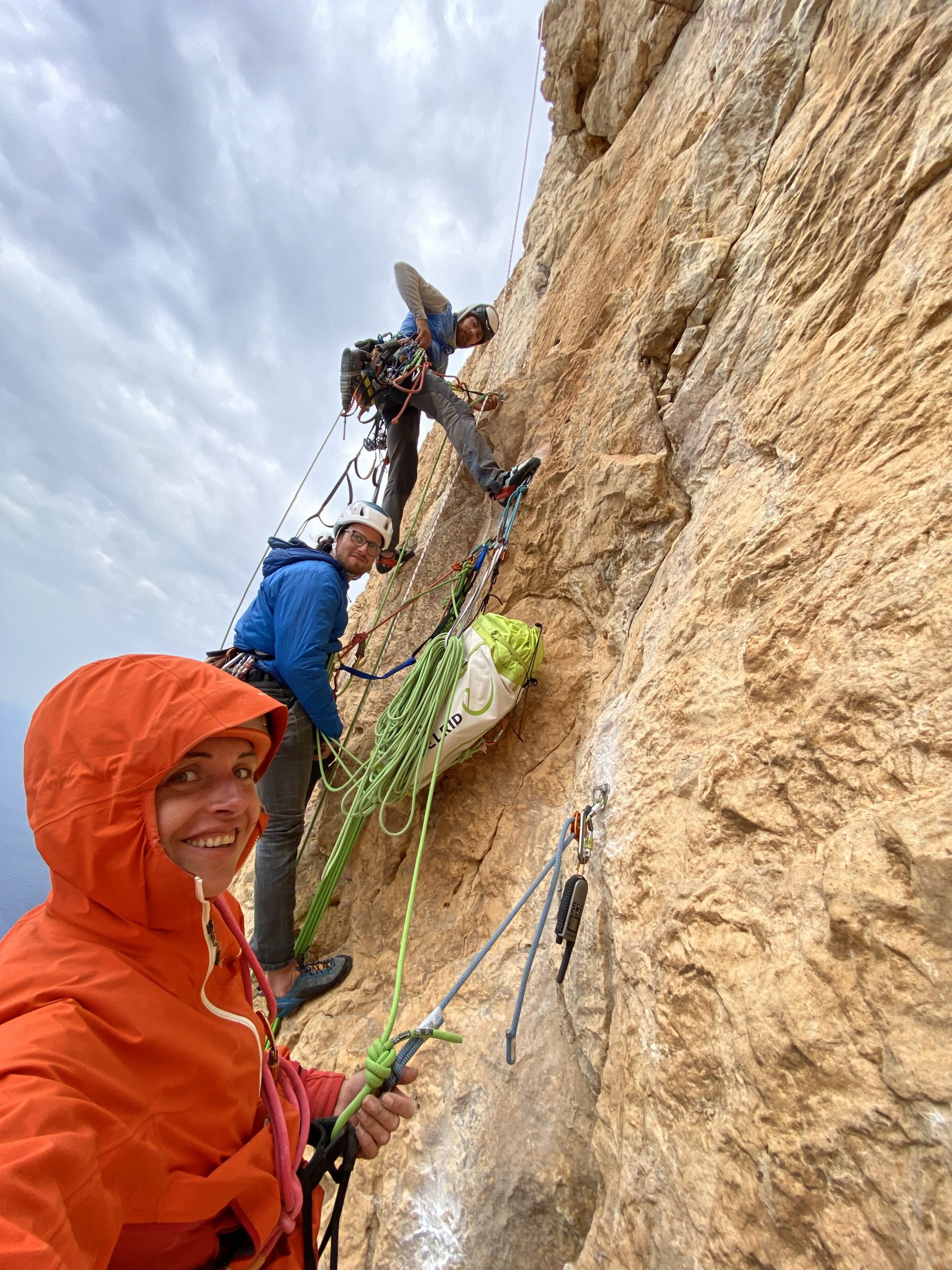
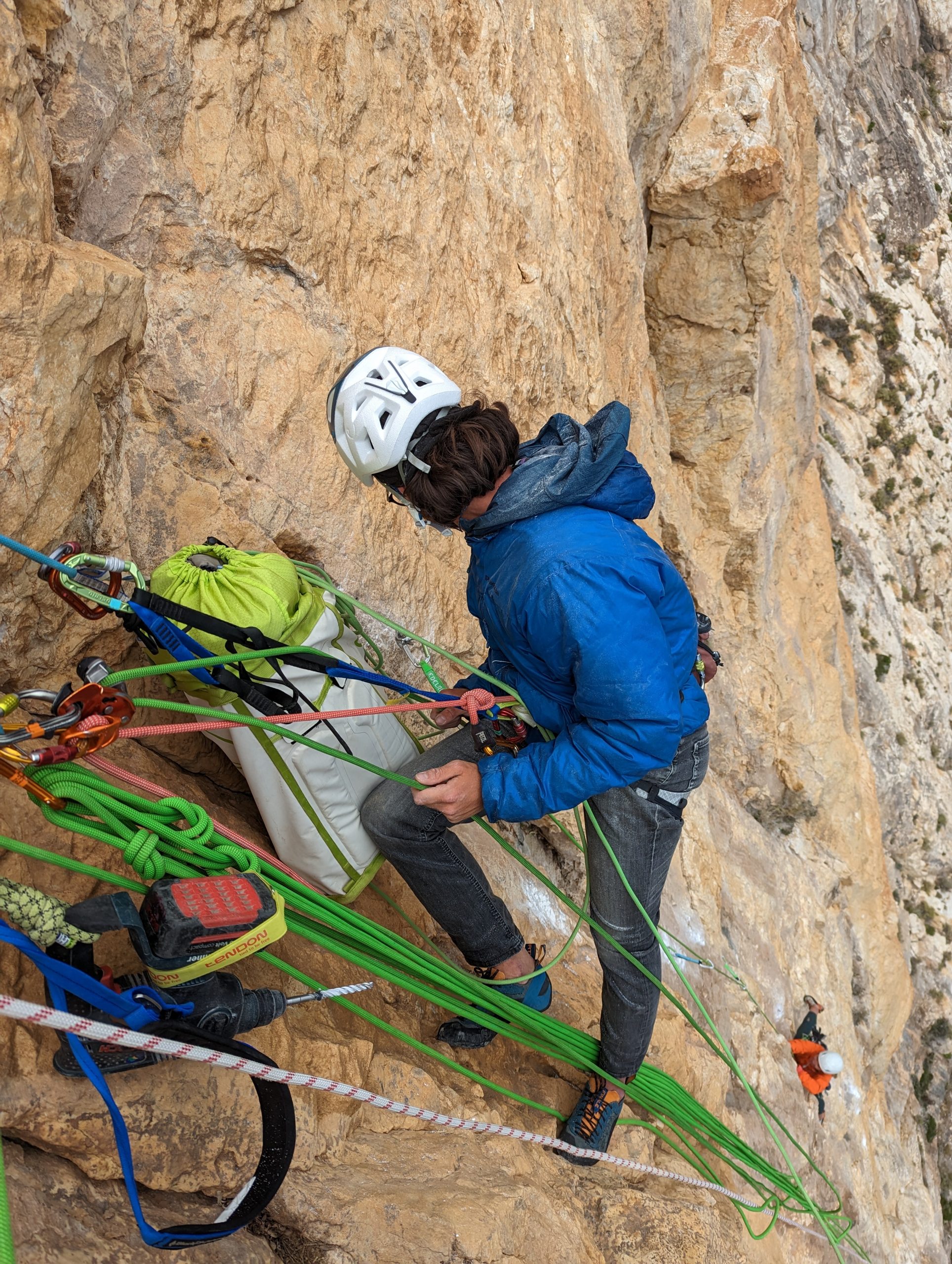



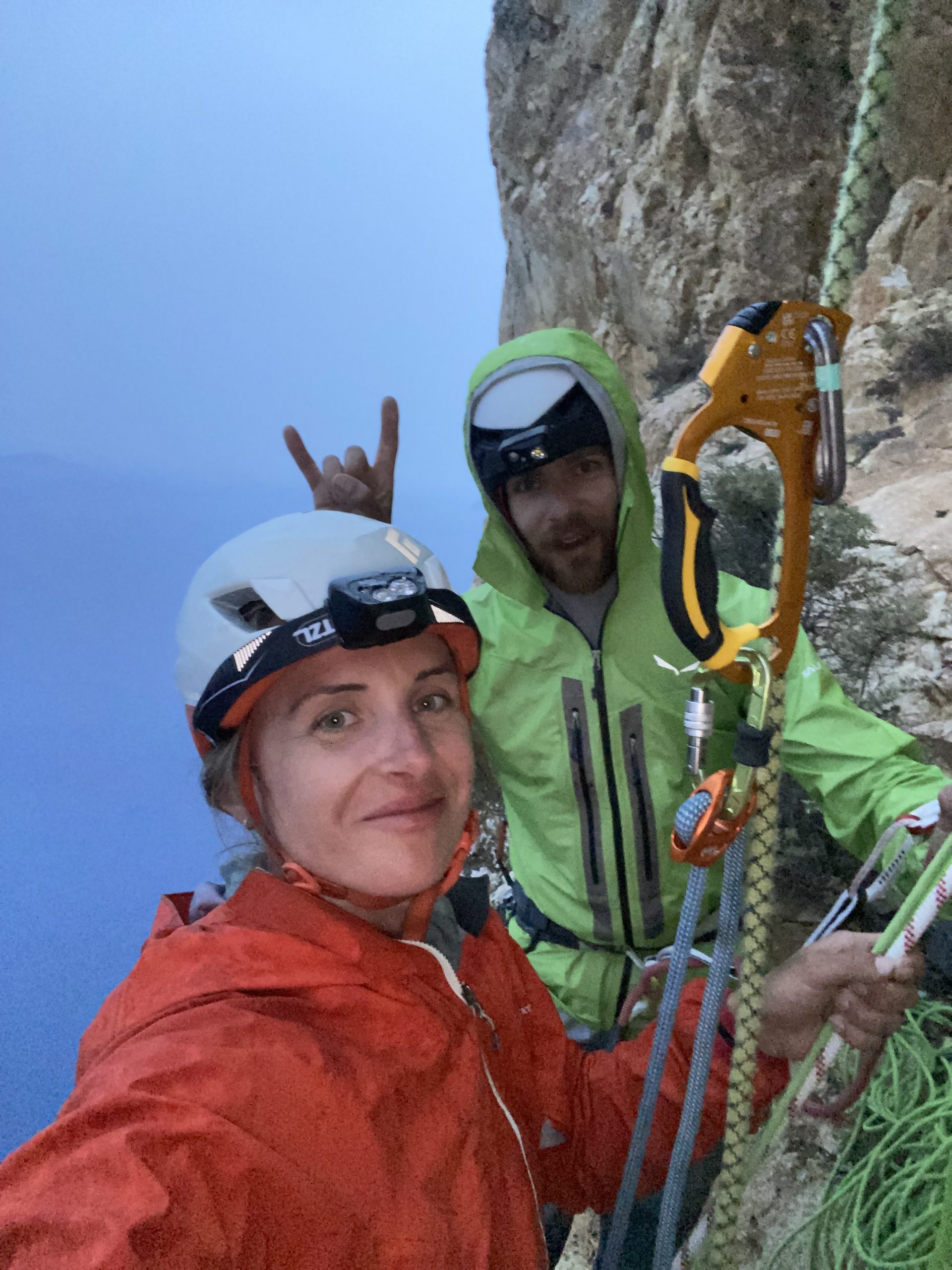
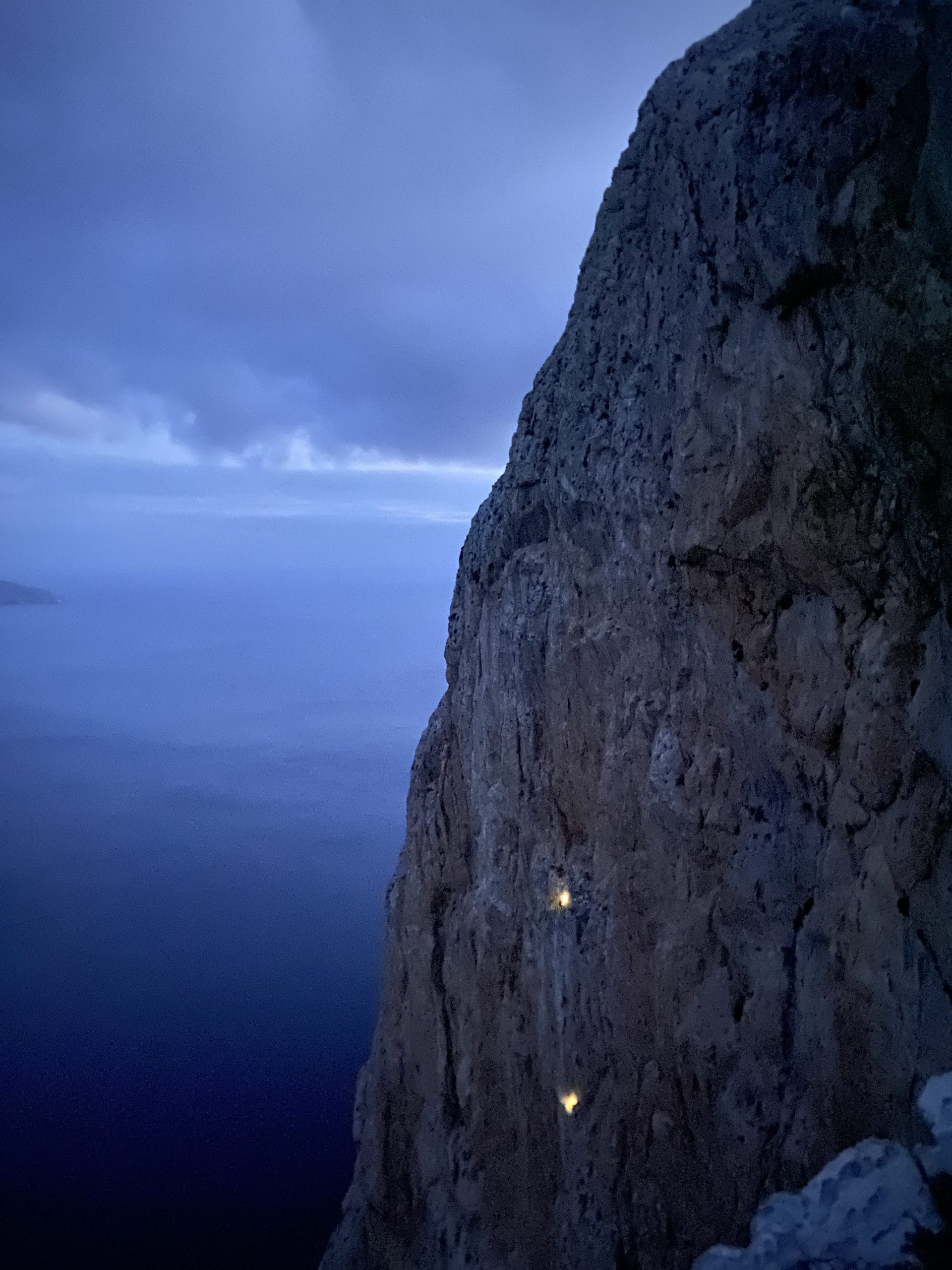
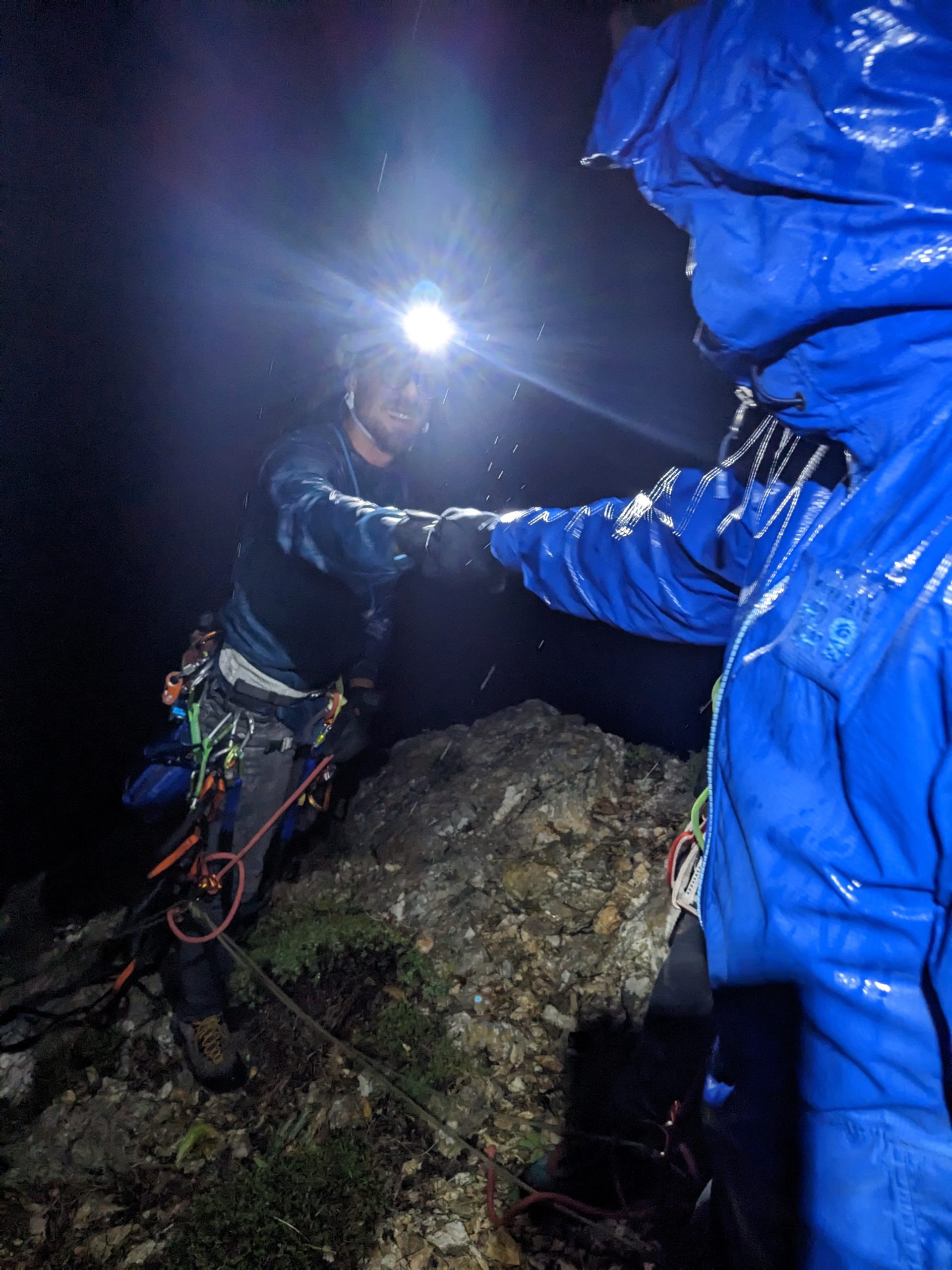
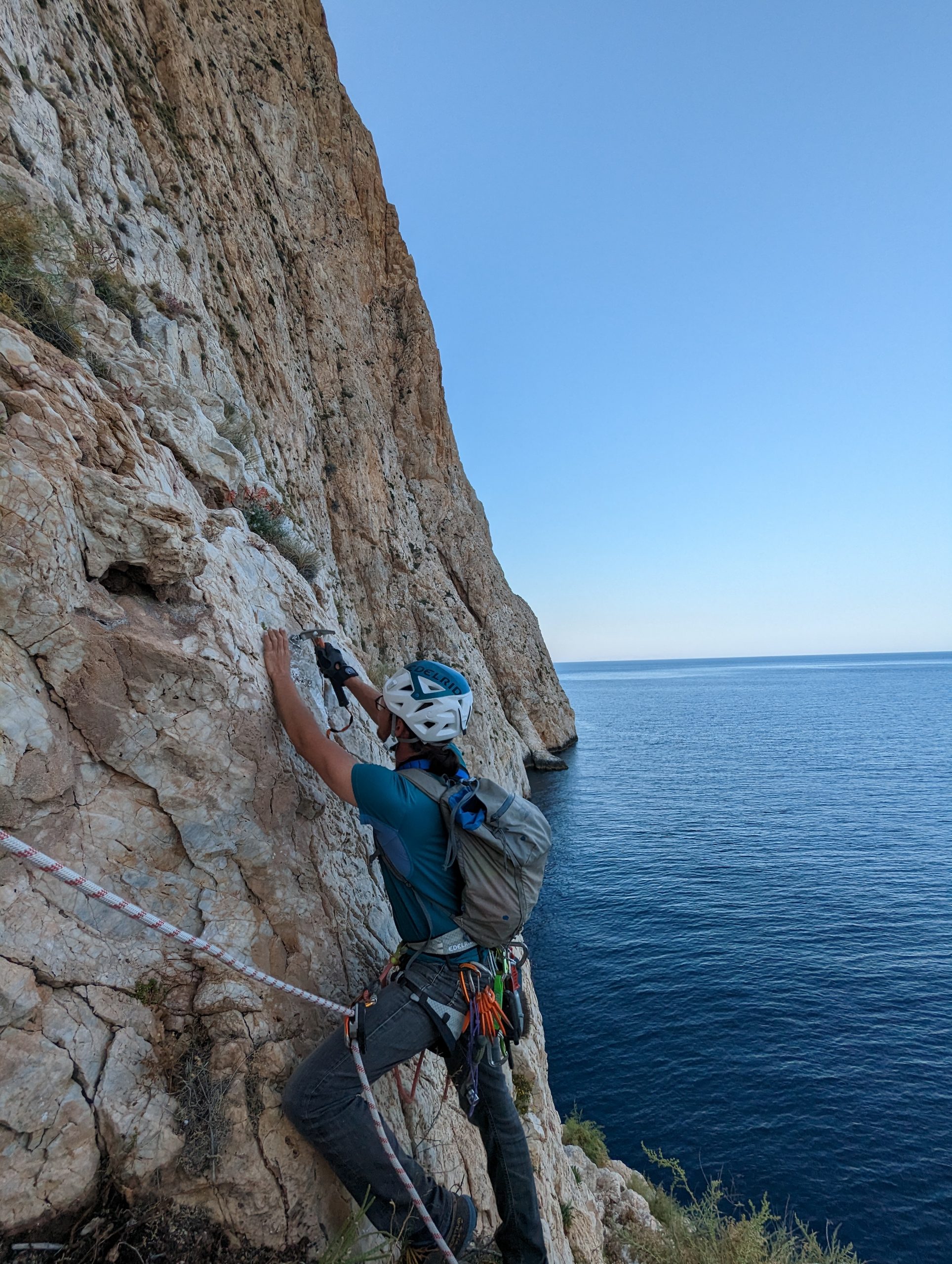
With the route bolted and ready for an attempt we were all psyched to get on it. The forecast for the next few days was looking perfect from a climbing perspective since it was supposed to be fairly cloudy, with wind and no precipitation. However, as we had learned by then the wind was also the main factor affecting our intended boat approach. So we had to push our attempt later than planned and hoped the wind would drop in order to be able to actually get on the route. Luckily, the nerve-racking waiting didn’t last long and on the 28th of May late in the afternoon, we got on the boat for a bumpy ride to the base of the route. Around 17:00 we reached the base of the route and with some shenanigans, all of us got on the ledge 5 m above the water at the beginning of our route. From that point on we were committed and super excited that it was actually happening. We said goodbye to the boat and got straight to business since we were planning to clean and free-climb the route over the next two and a half days and we were already slightly behind schedule.
The first afternoon on the wall went smoothly and by climbing in two individual parties by dusk we made it to the bivy ledge right underneath the headwall. The climbing on that first part of the wall was fairly easy with a mixture of slabby terrain, steeper pitches, and ledges with loose dirt and rocks. Although we needed to climb fast and efficiently we also had to be extra careful not to throw down any loose rocks. After 8 pitches of varied climbing, we were ready for our first night on the wall. When we got to our stashed haul bags we had a surprise. A mouse made a hole through one of them and managed to get to our food bag but luckily was only interested in our delicious peanut butter honey wraps and didn’t have time to go through all of our food. So we named the bivy spot the Mouse Ledge. After a good dinner, it was time to get some sleep and rest for the next two full days of sustained climbing on the headwall.
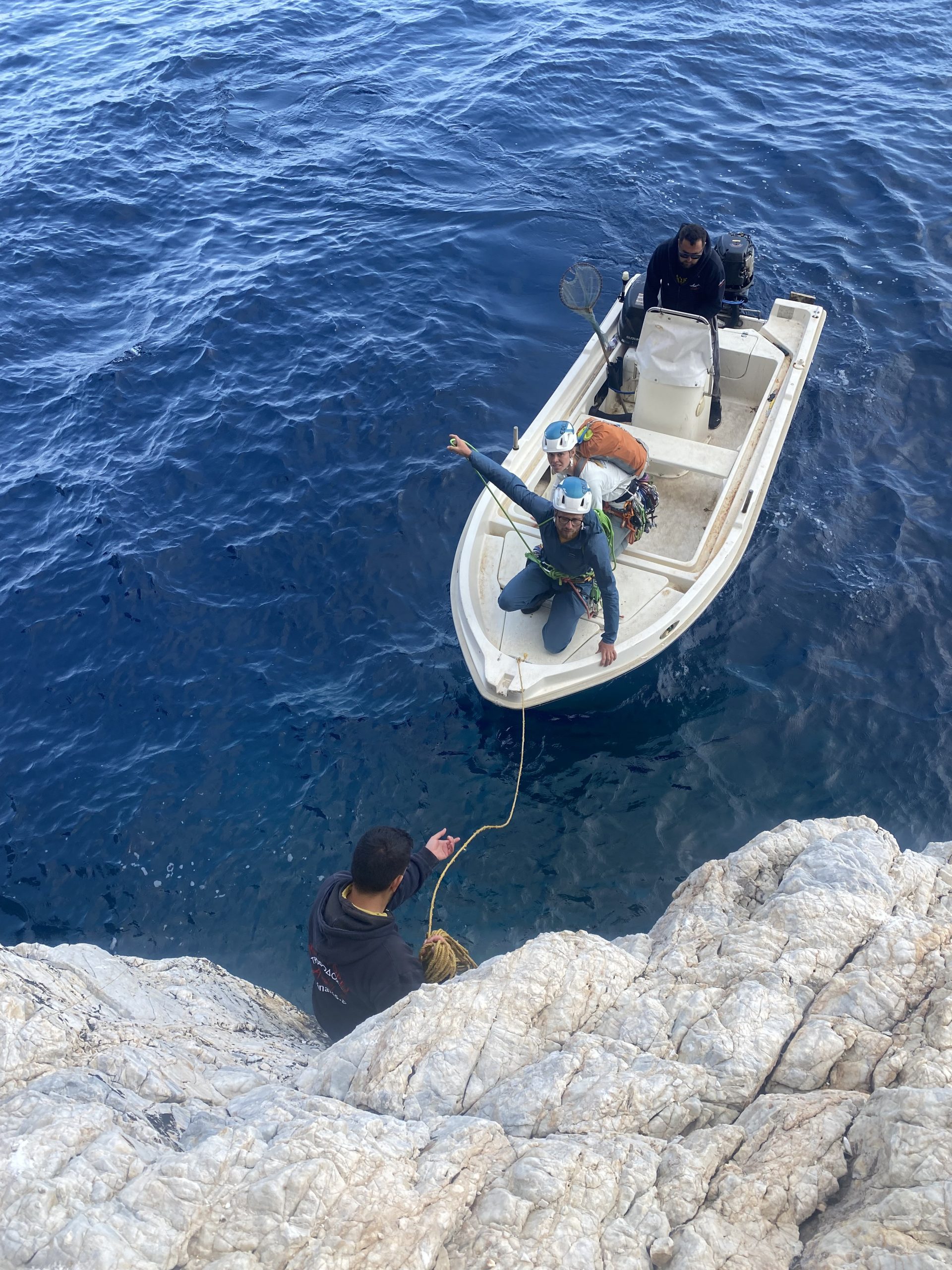
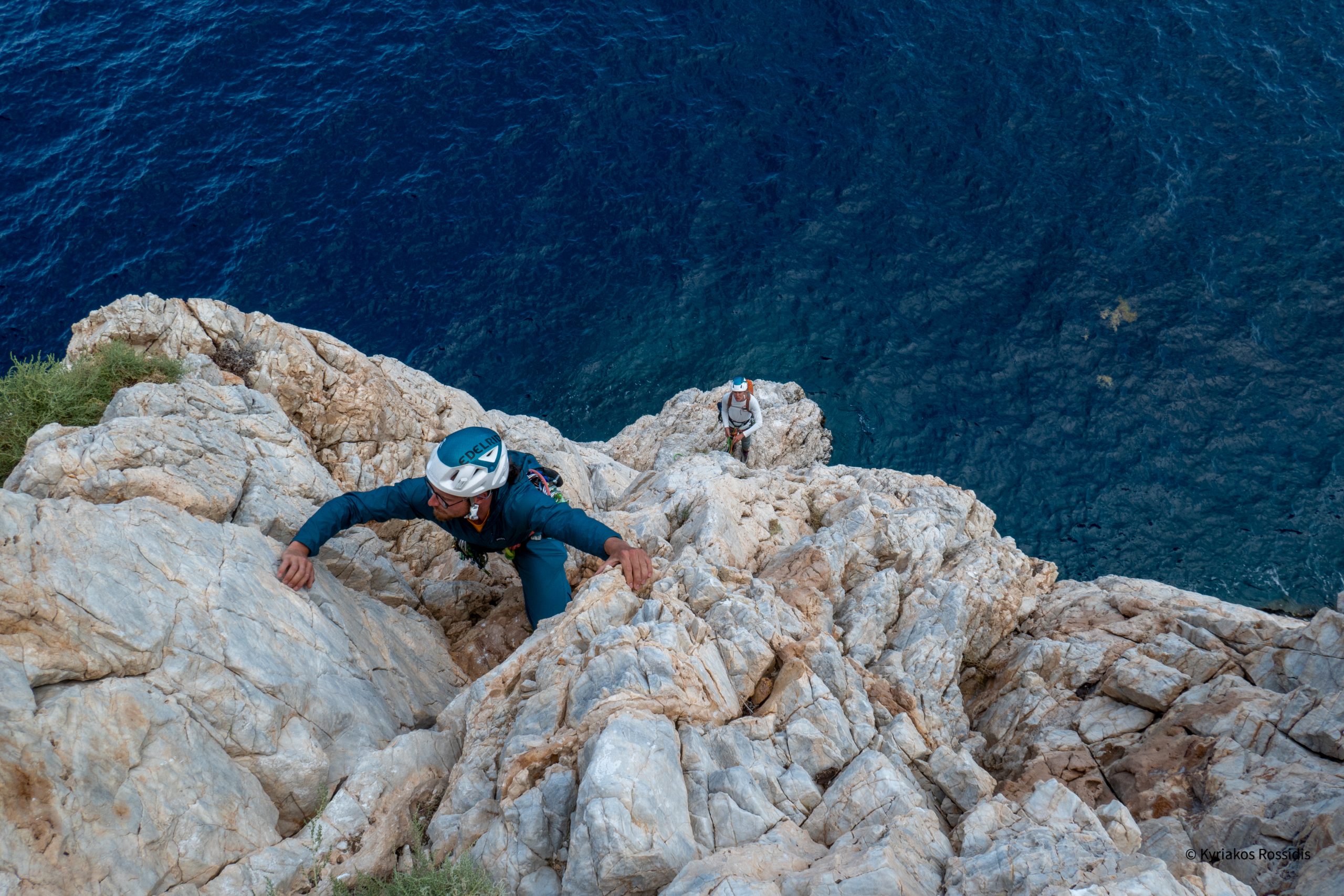
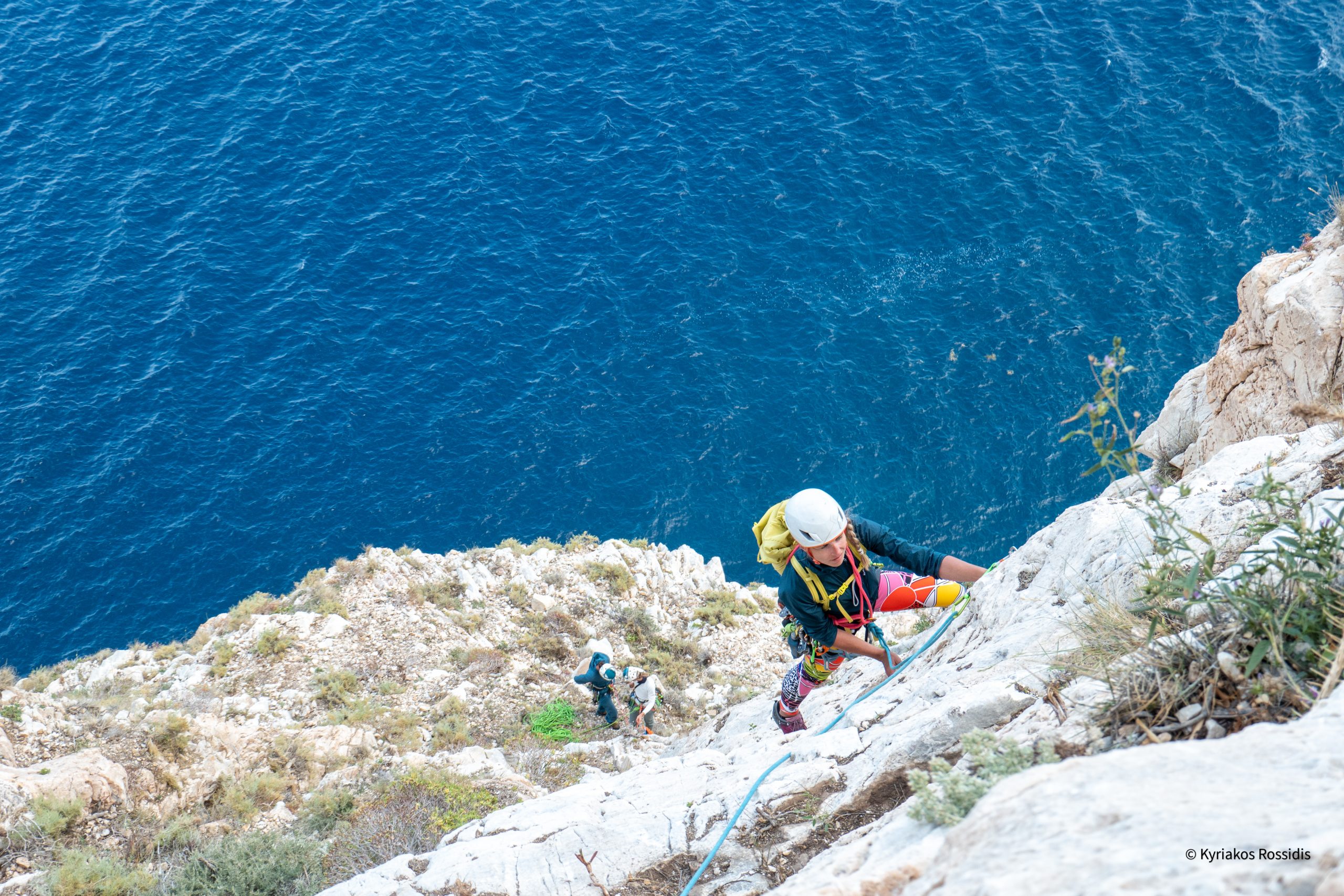
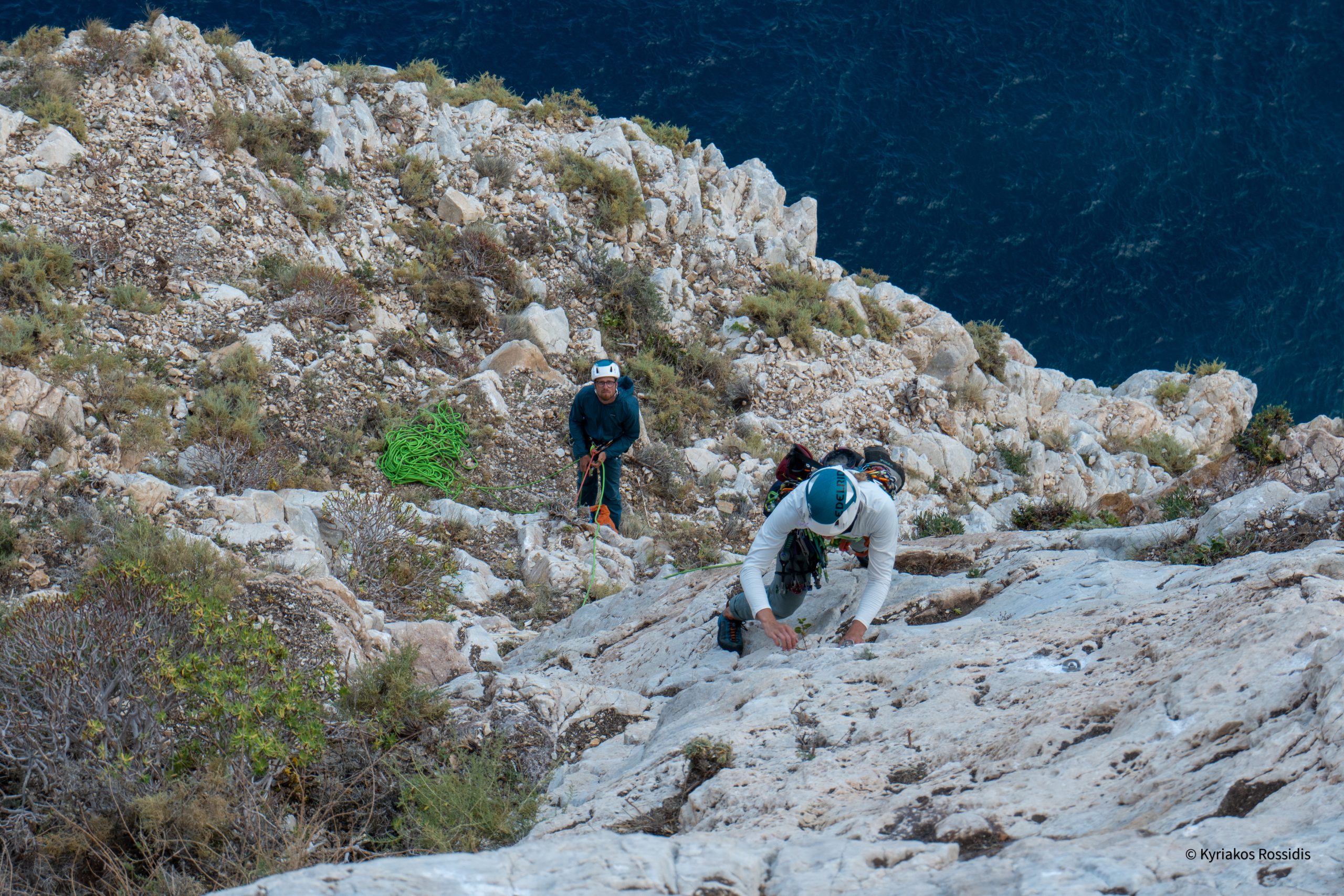
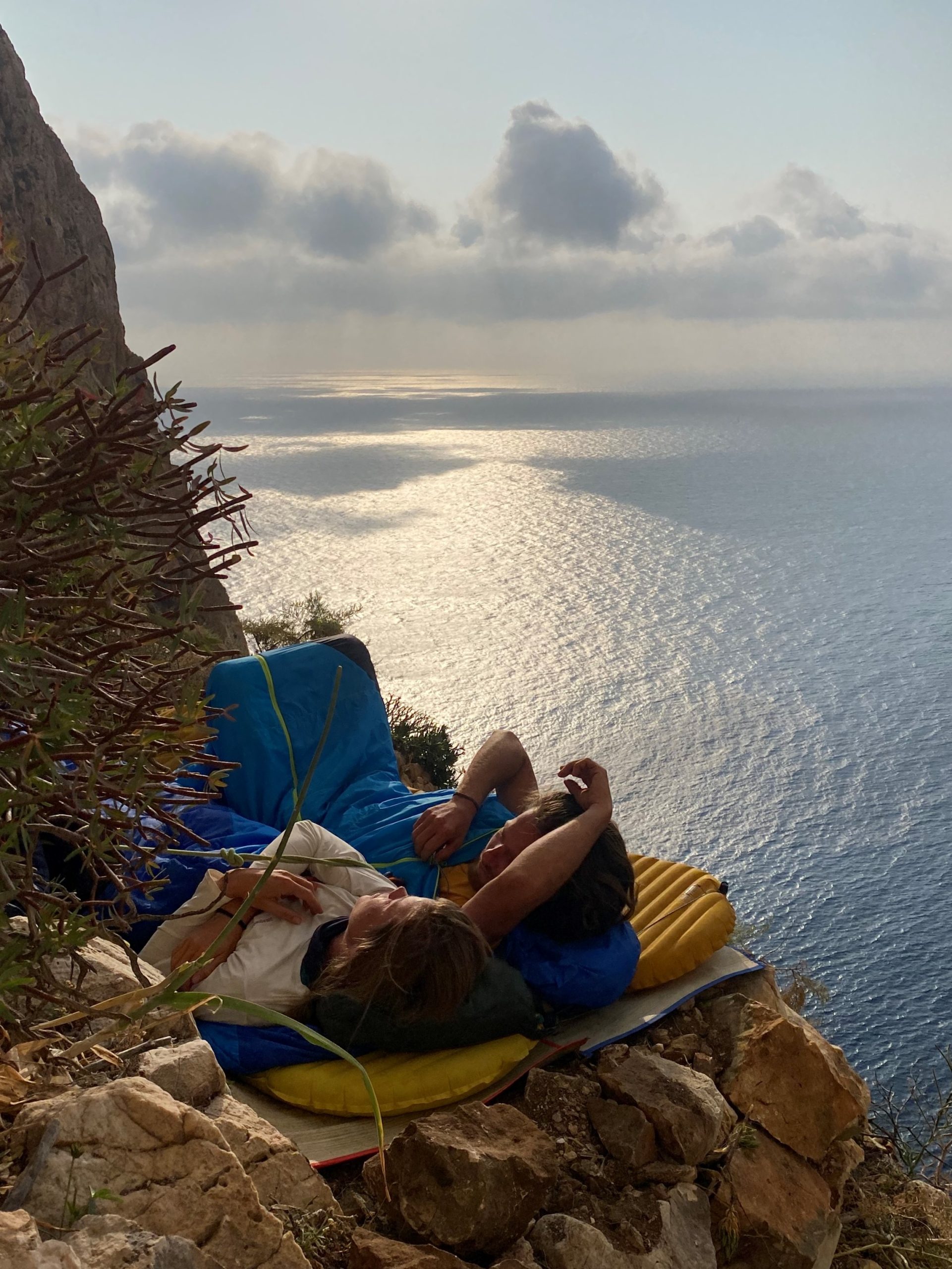

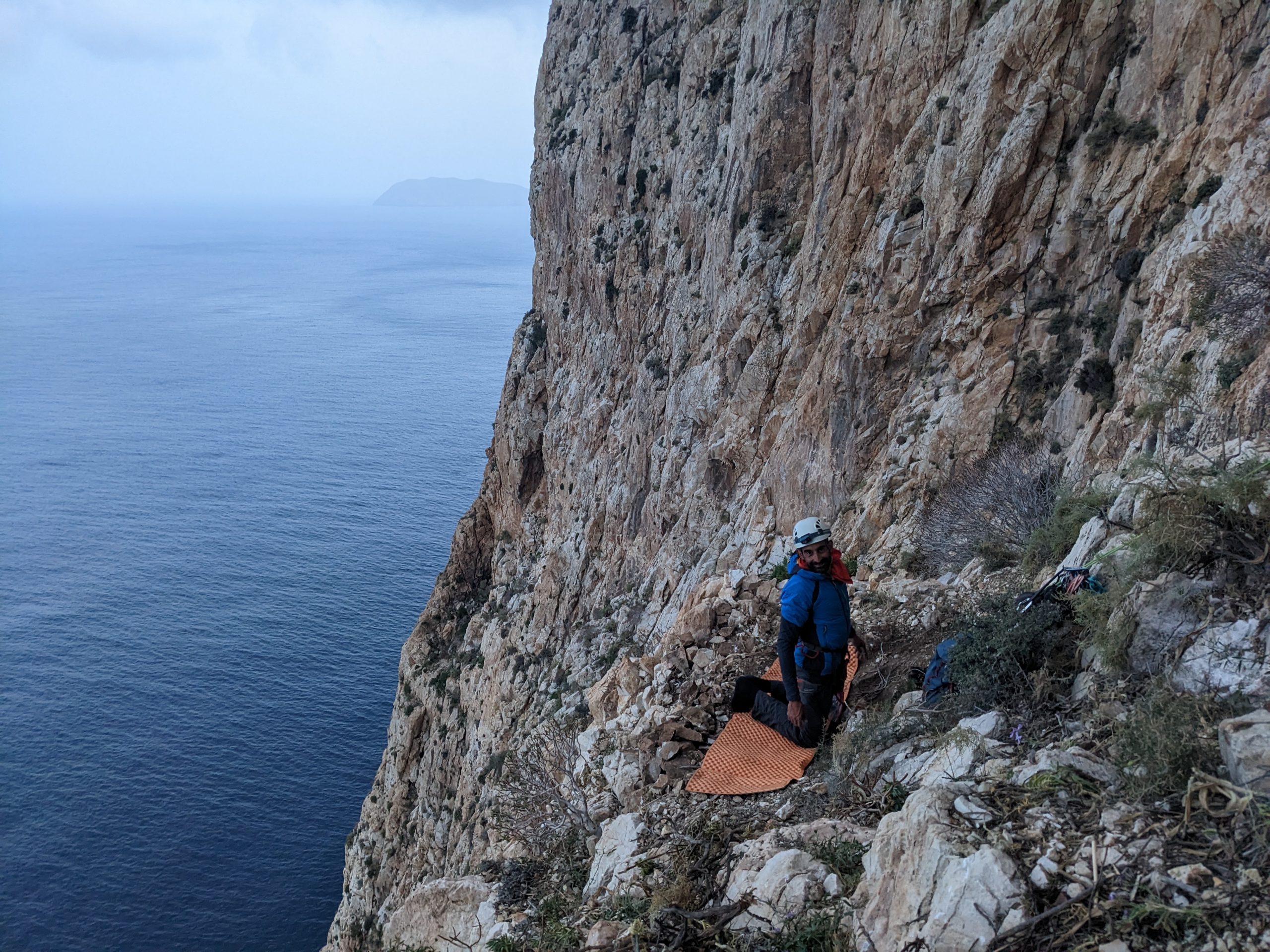
The first morning on the wall found everyone pumped for climbing and after a quick breakfast, we were ready to tackle the headwall. We were still climbing in a party of 3 (Dana, Constantinos, and I) and a party of 2 (Andreas and Jenny) with the only difference from that point onwards that we had to treat it as a big wall and haul our bags with food, water and bivy gear. The first 2 pitches above the Mouse Ledge went smoothly and they got us well warmed up and ready to fight. We managed to free the next 4 pitches on the first go while cleaning and brushing dusty holds on the lead and by the time we reached the crux pitch right underneath the Party Ledge we were already tired but still fired up for a battle. I gave a good fight but after spending too much energy on the steep crux trying to figure it out and cleaning a crucial pocket I took a whipper and so I decided to just brush and clean as much as possible and climb to the Party Ledge since it was already getting late. Andreas also had a really impressive attempt but he lost it on the same spot and since it was already dark we decided to give it another go the next morning. The second night on the wall found everyone in high spirits since the climb was going well and according to ourplan.
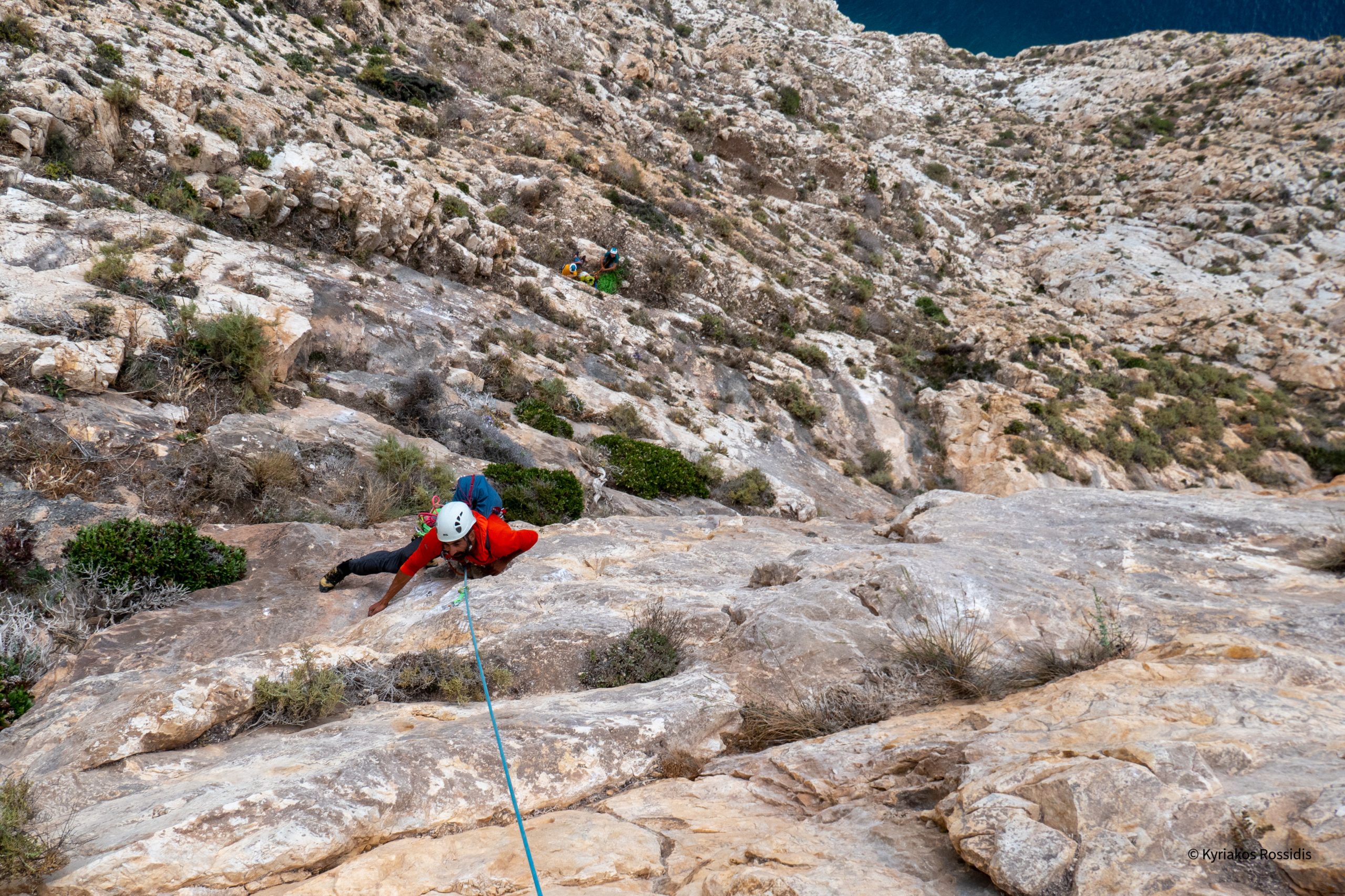
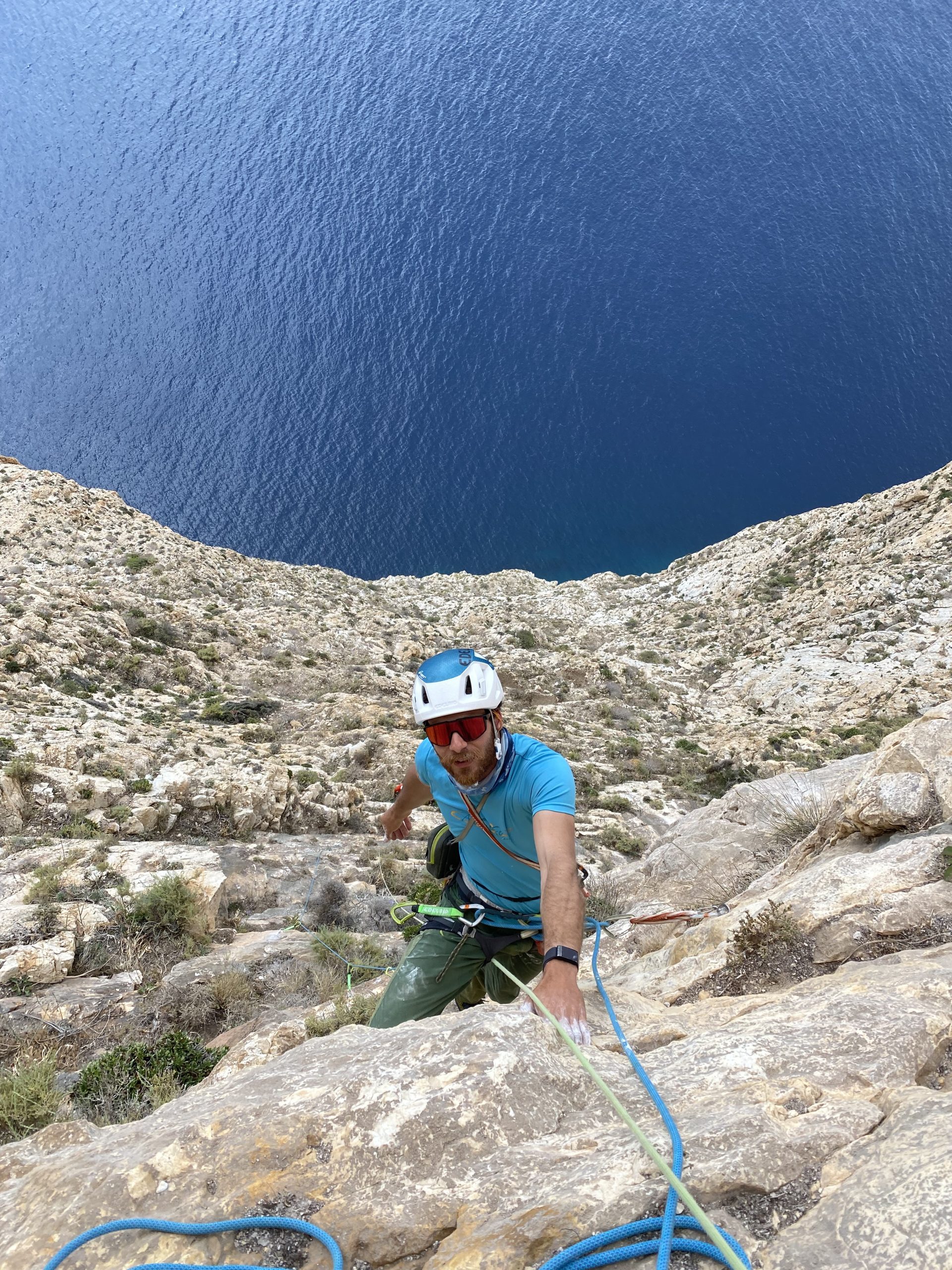
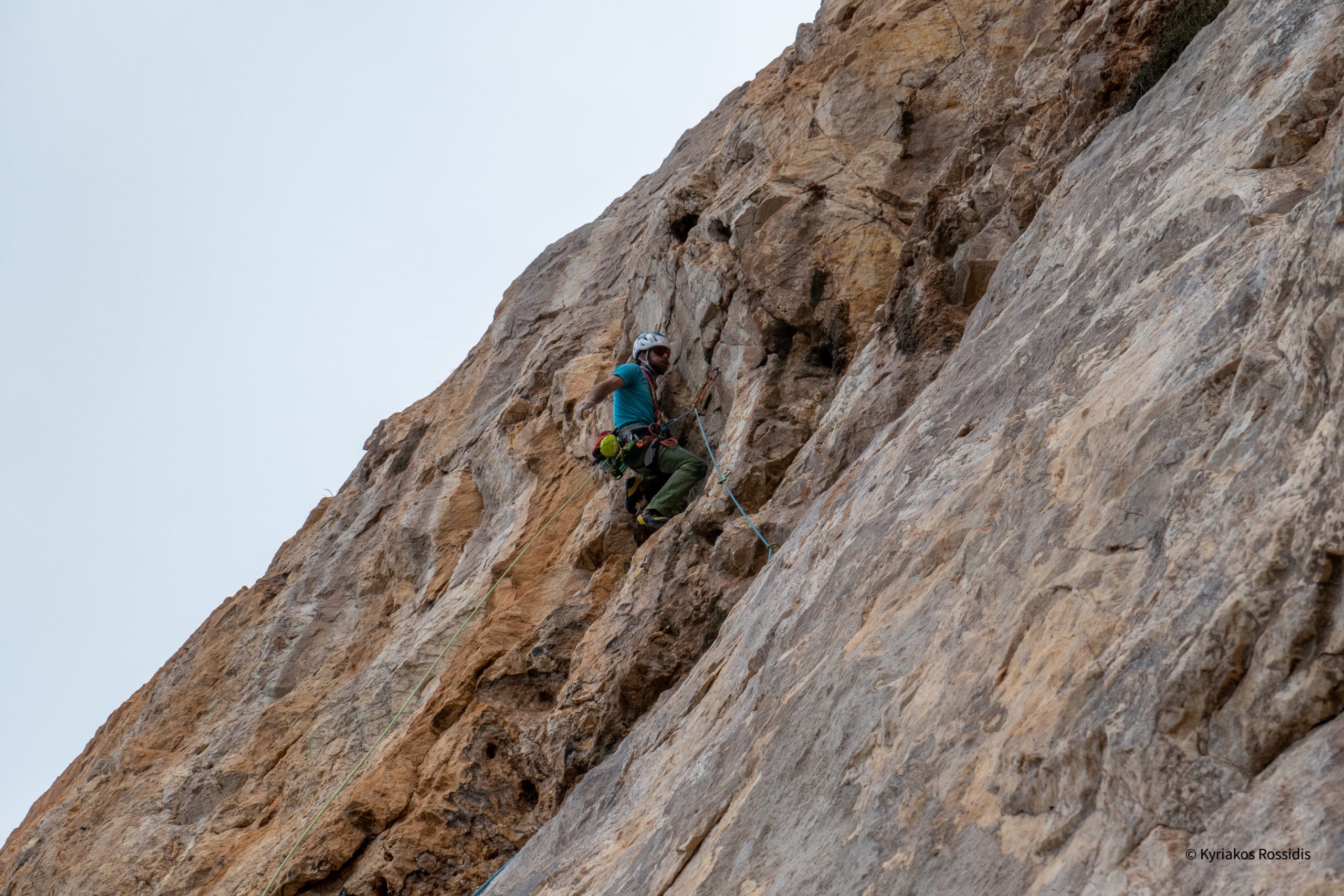
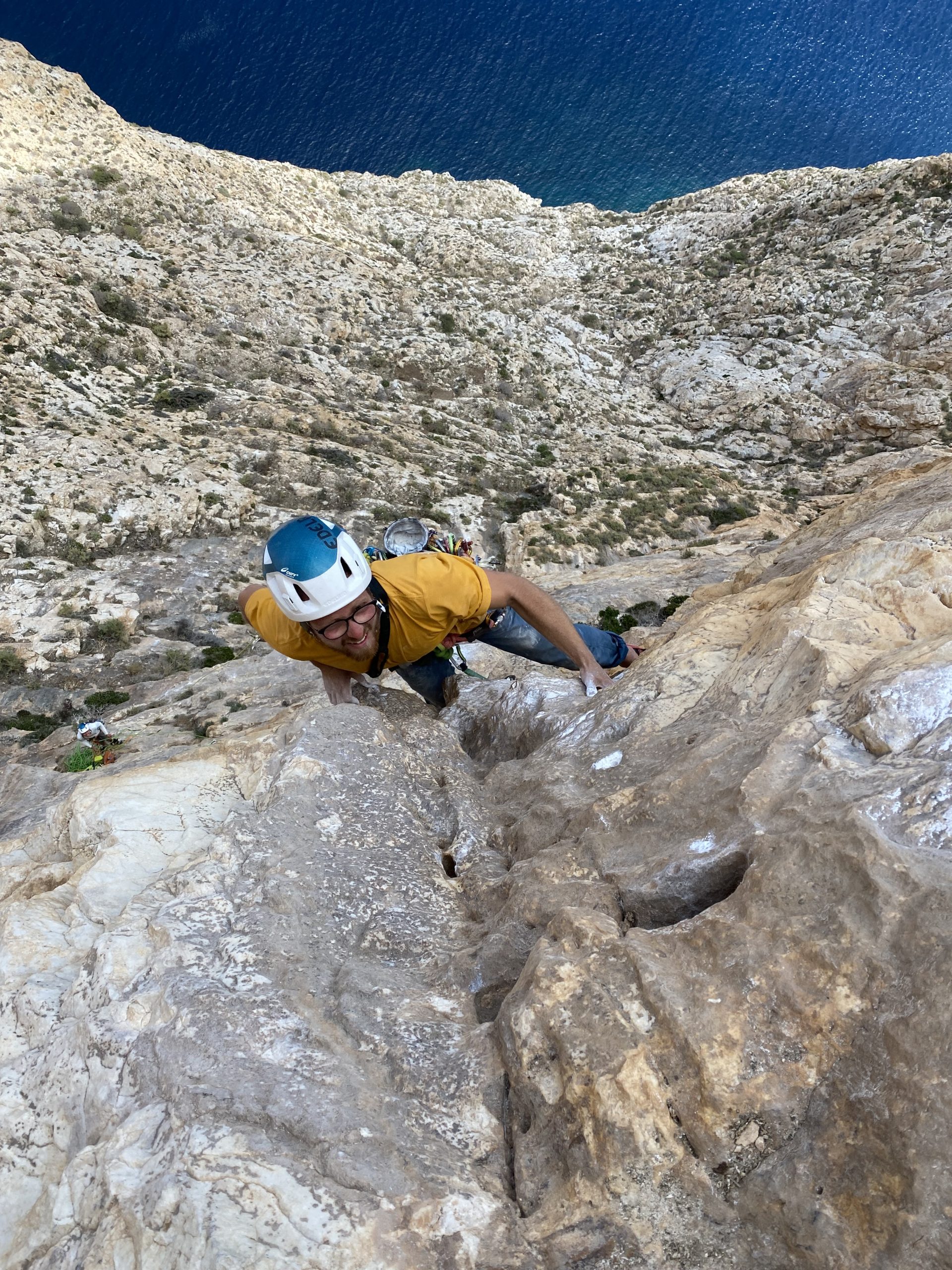

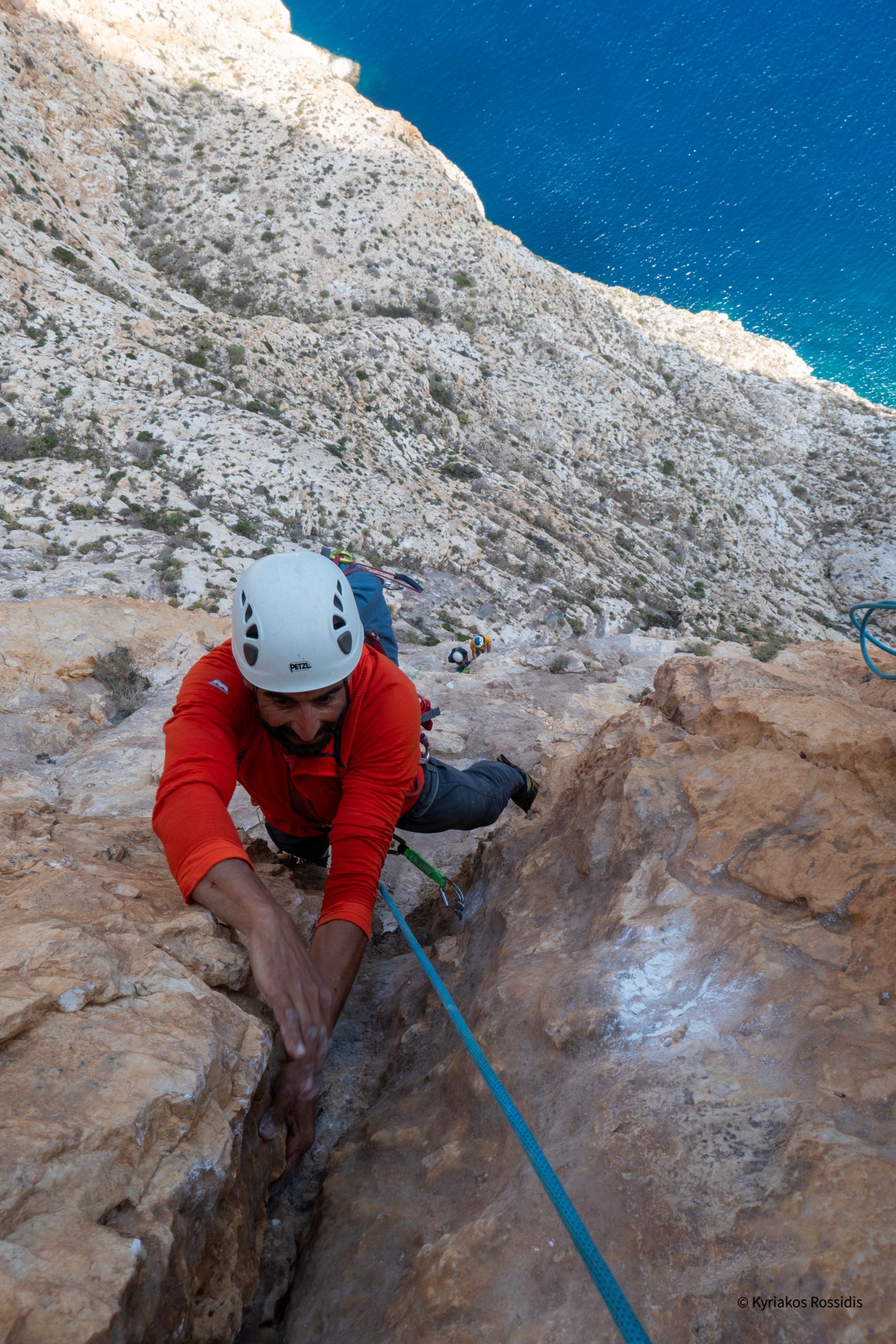
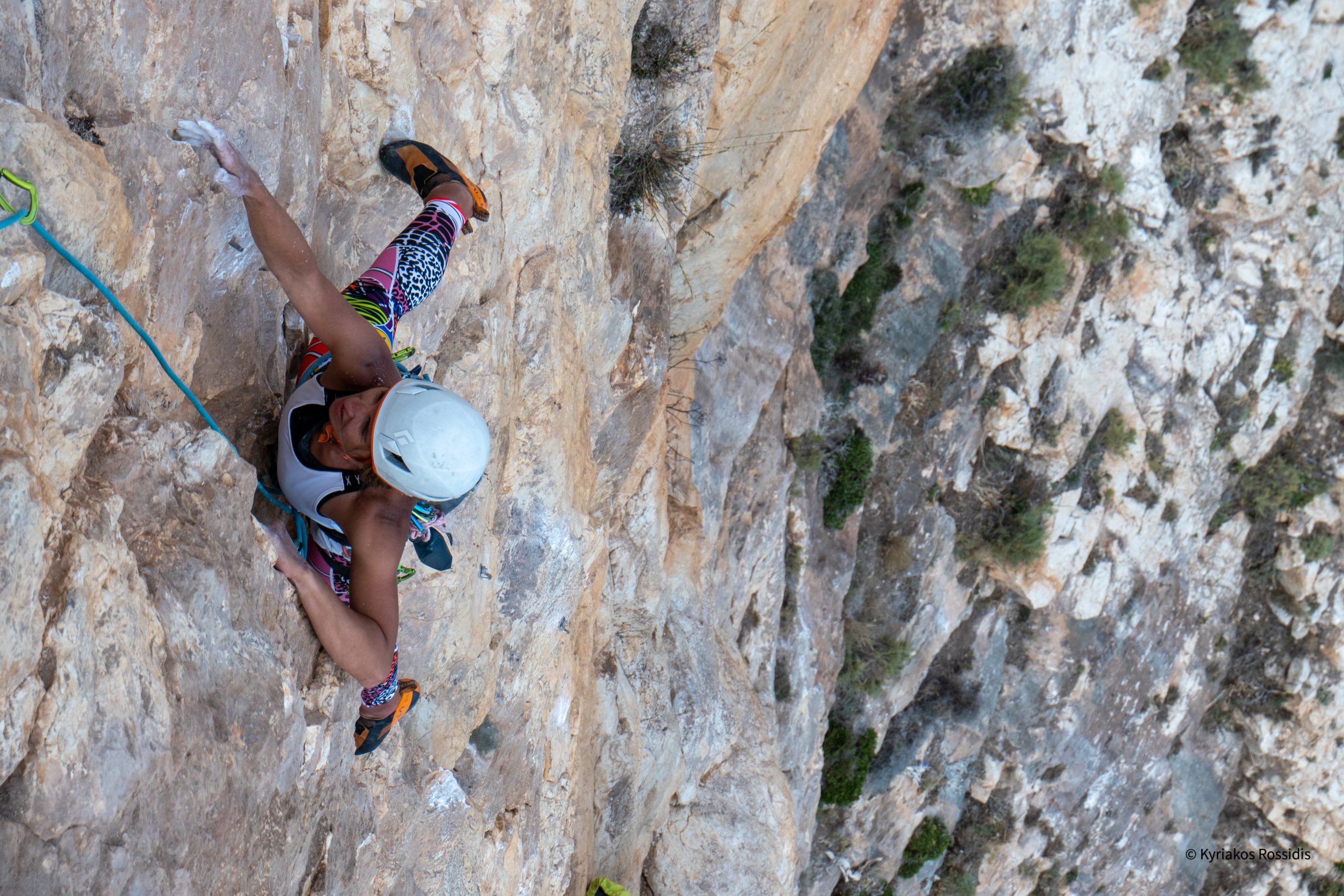
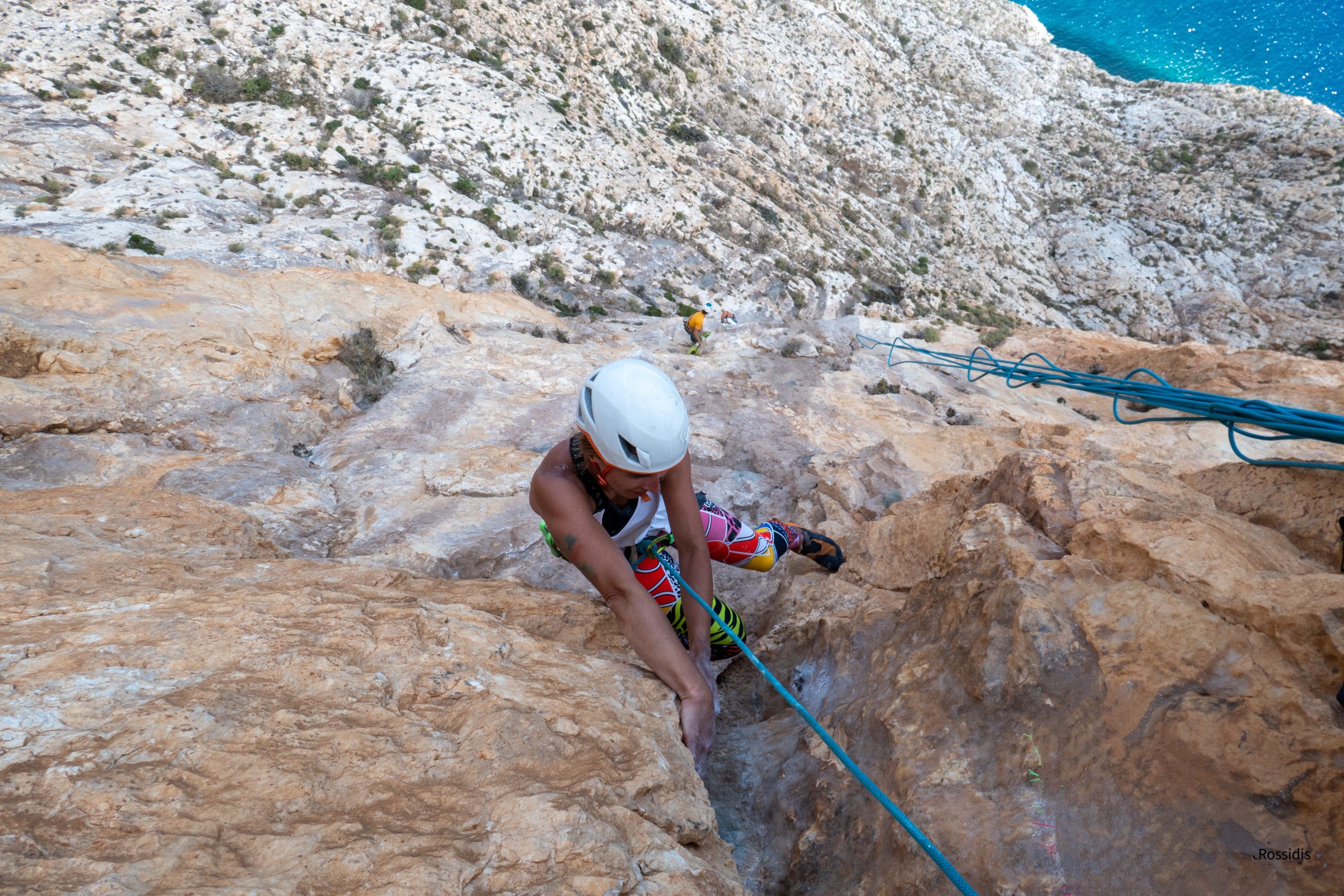
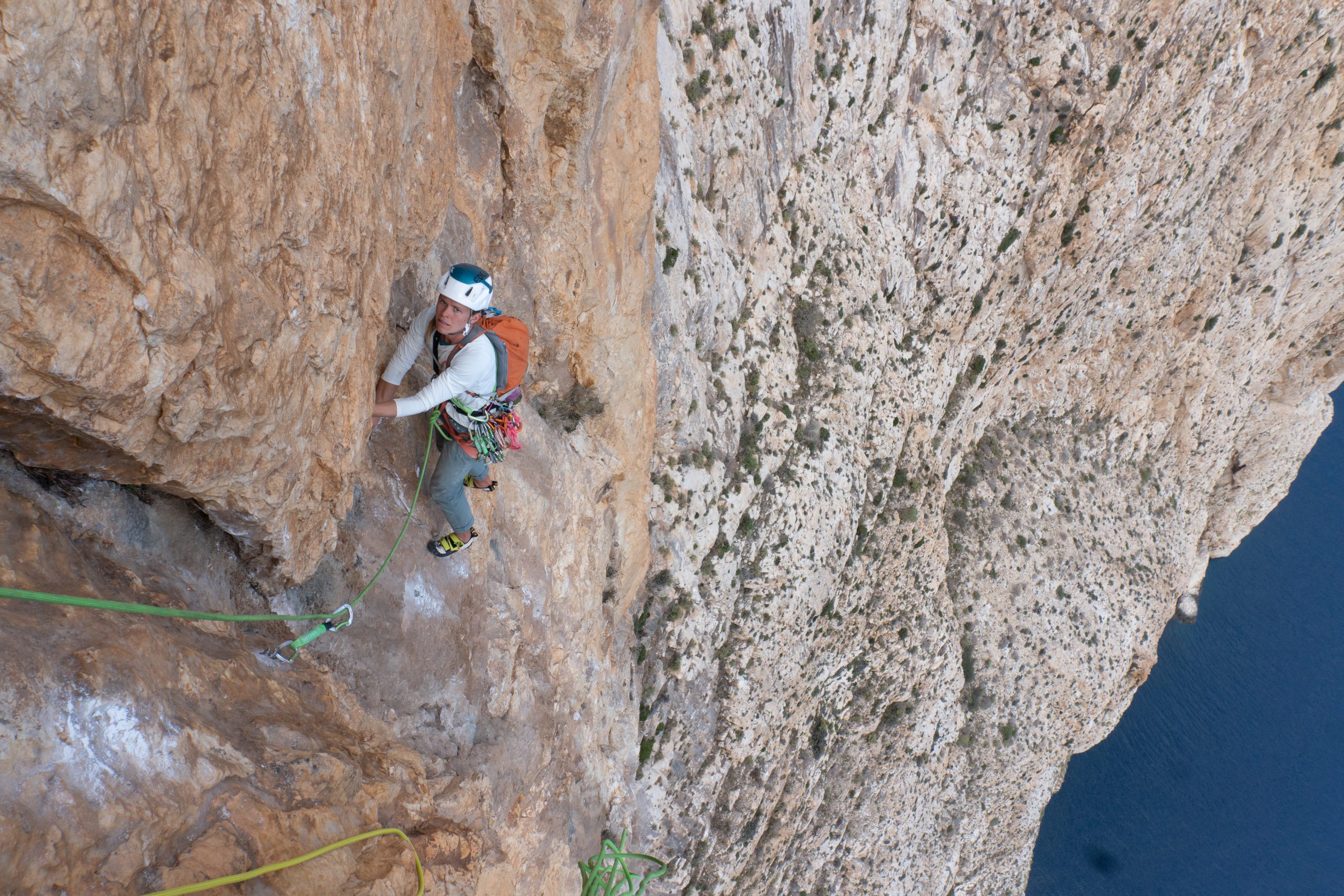
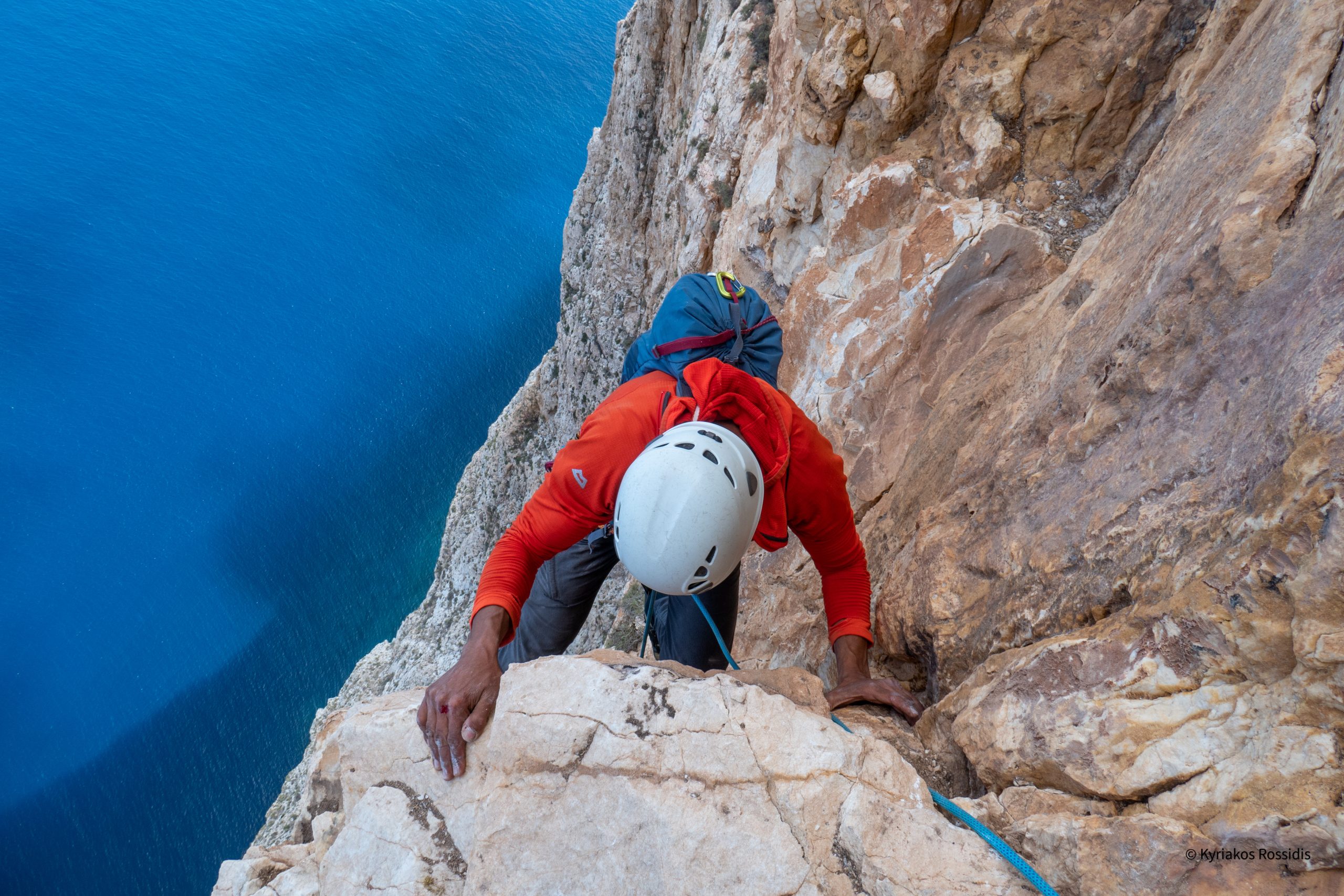
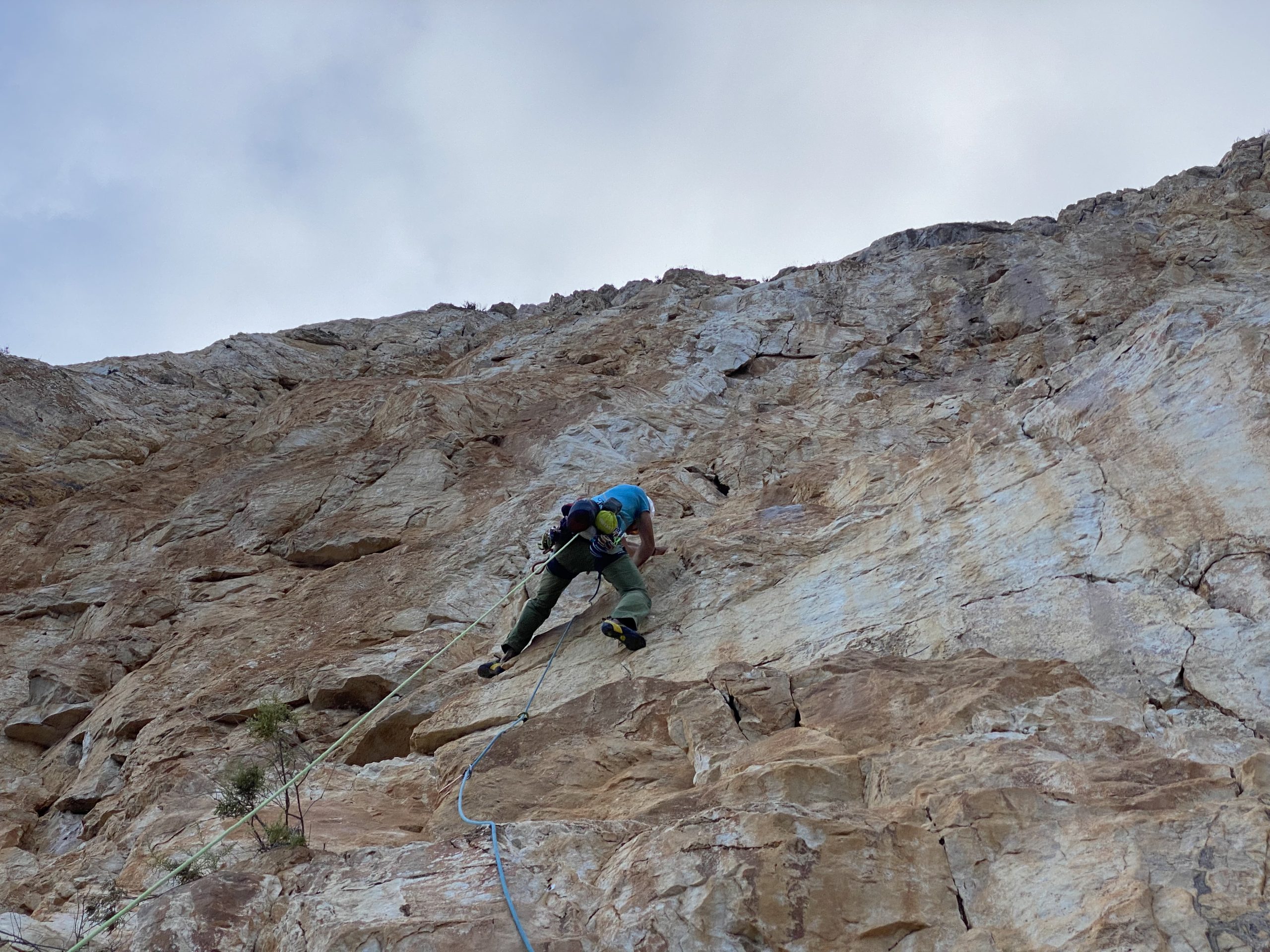
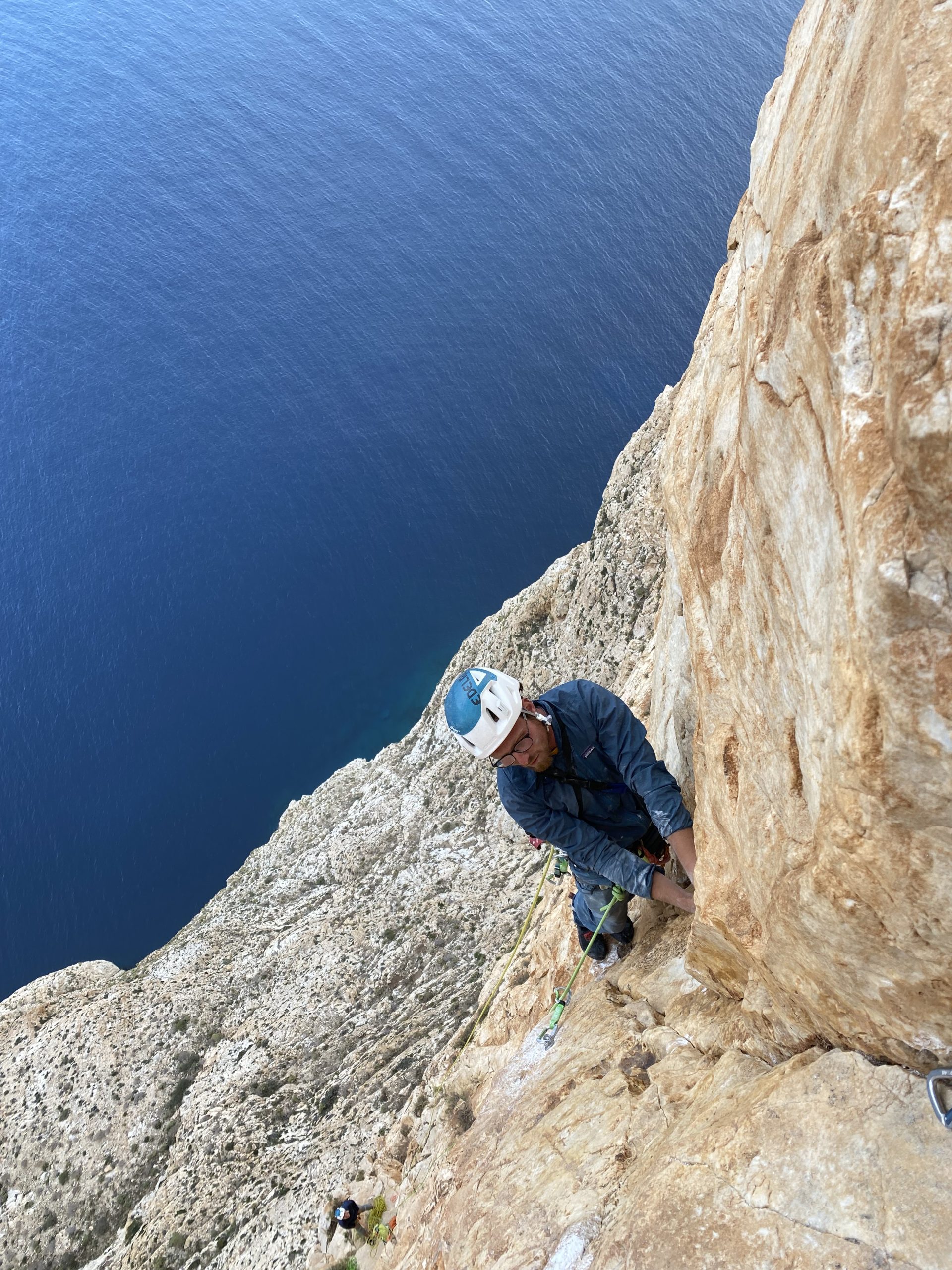
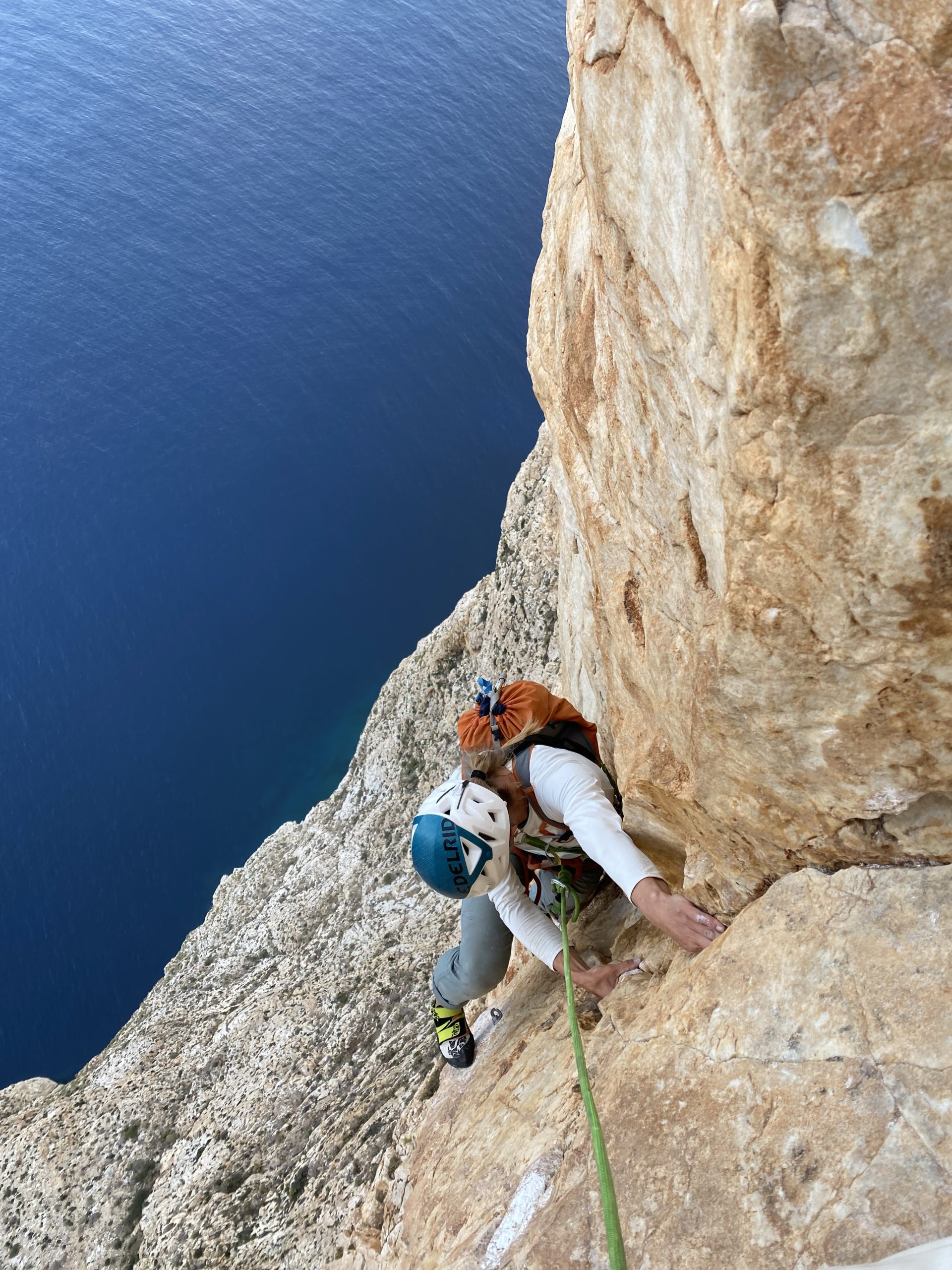
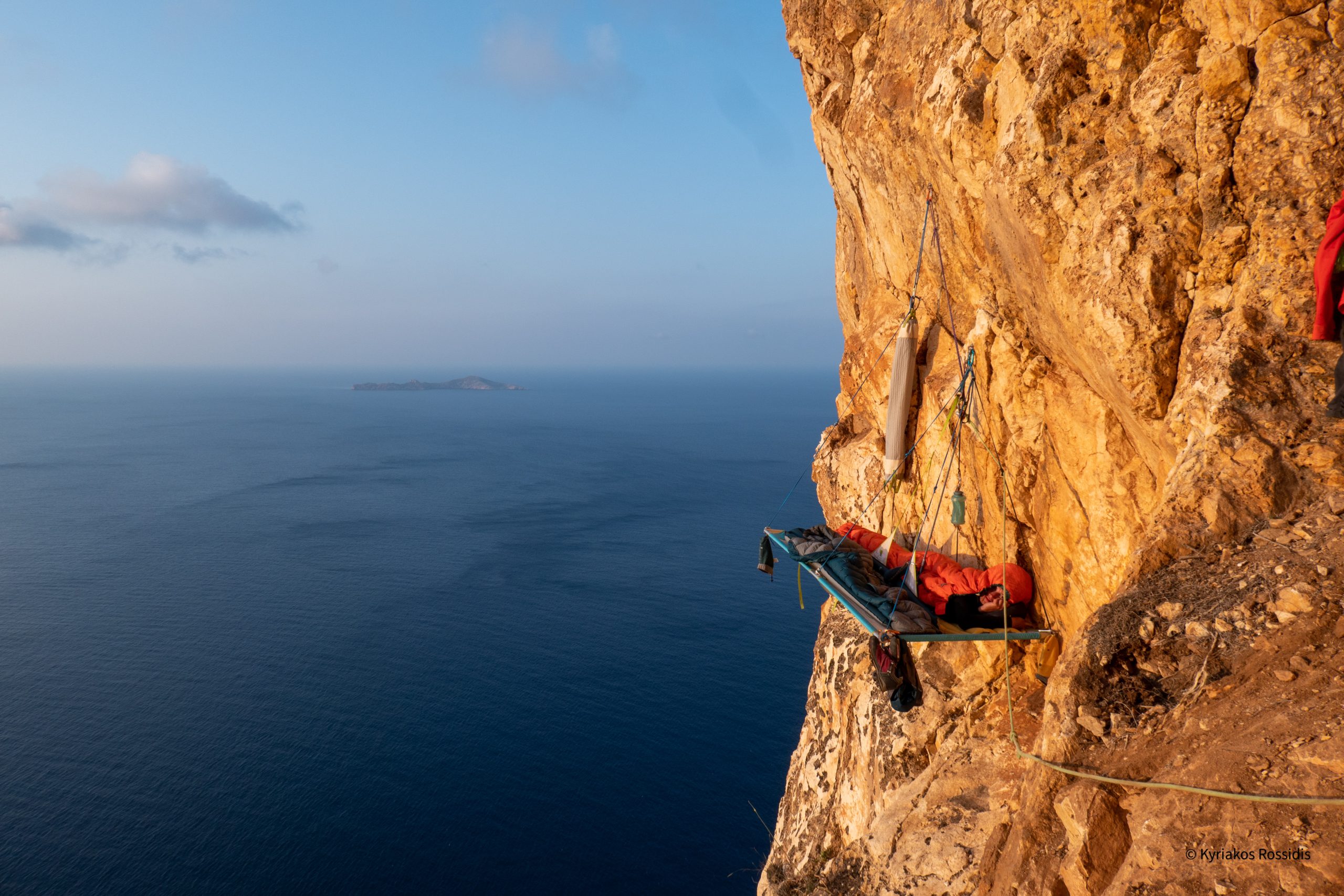
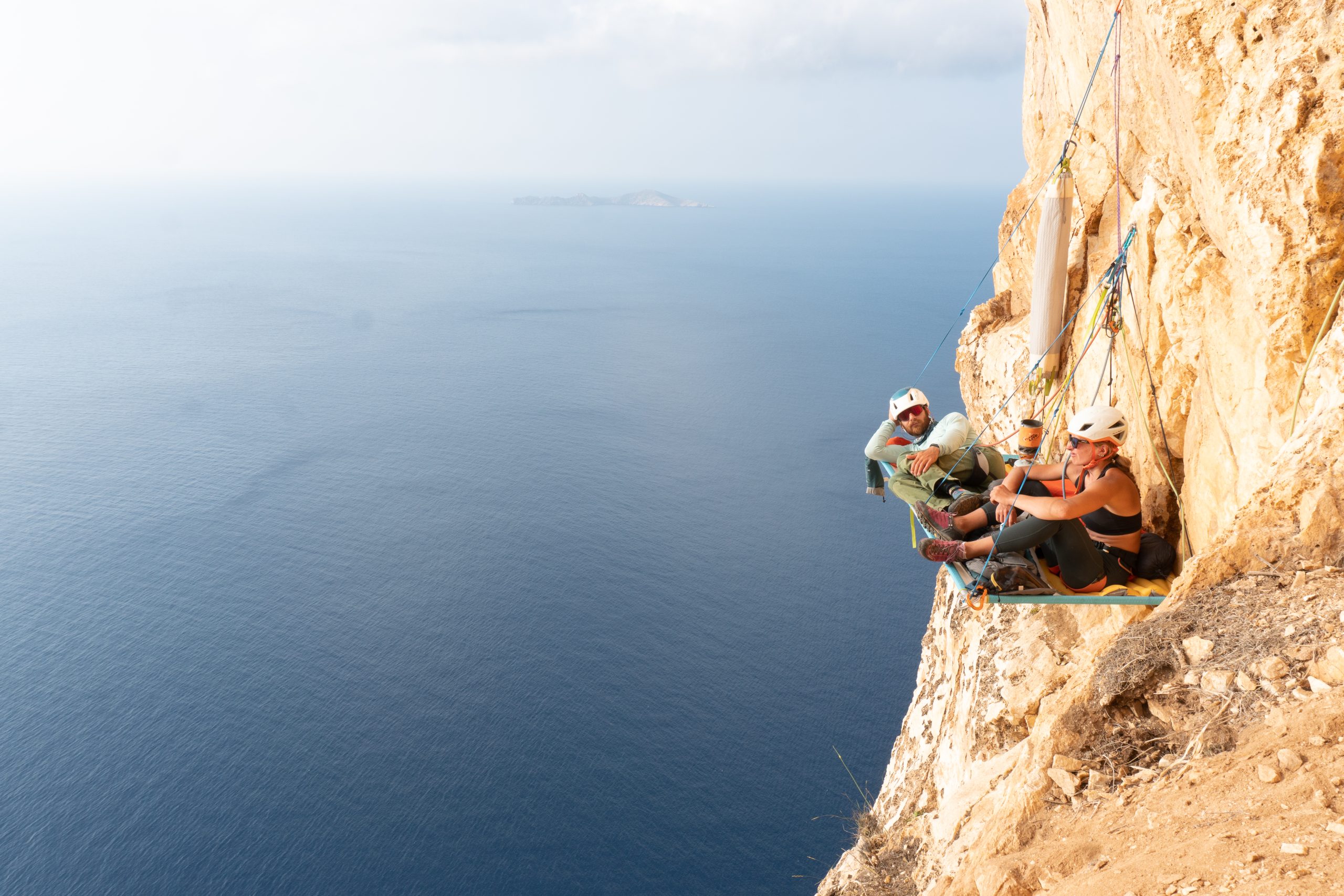
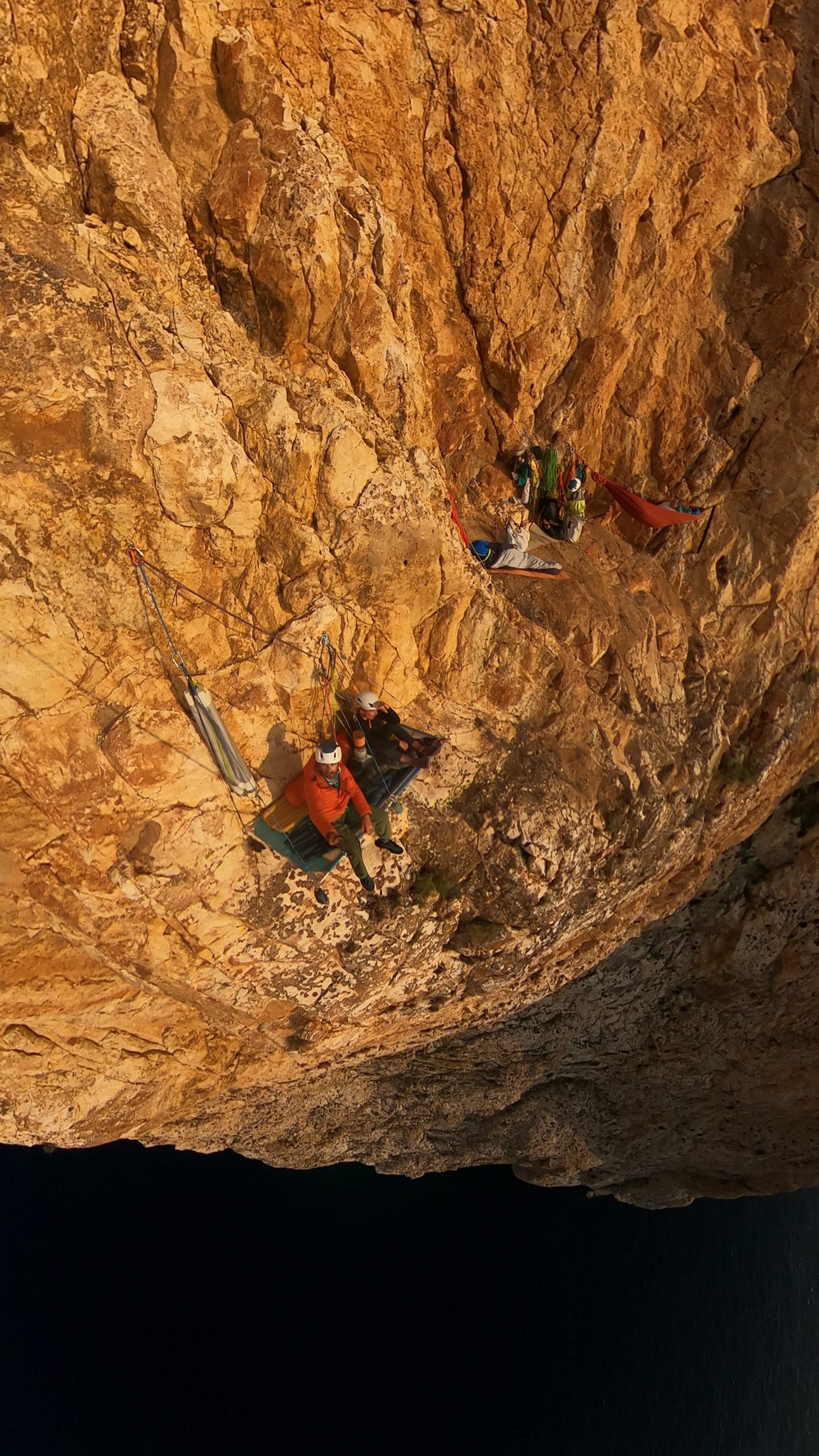
The second morning on the wall was special, everyone’s face was glowing when the sun started to rise from the sea, lighting the wall in a rich golden color. Let me tell you that, Santorini is worldwide famous for its sunset but trust me it doesn’t even get close to the sunrise in Anafi especially when you experience it from a ledge in the middle of a 500 m wall above the water. After taking in the views while having breakfast, it was time to abseil down and give another go on the crux pitch. On my first attempt, everything fell into place, I executed the moves almost perfectly and managed to free it. Back on the ledge and with all the pitches underneath freed we packed and got ready for the final section of the climb. The upper part of the climb, even though it had some hard technical pitches, went smoothly and we managed to free all the remaining pitches first go. We topped out all ecstatic and content that all the hard work we had put into the project ended up with such a nice line on an unclimbed face that offered some amazing climbing that we could actually free.
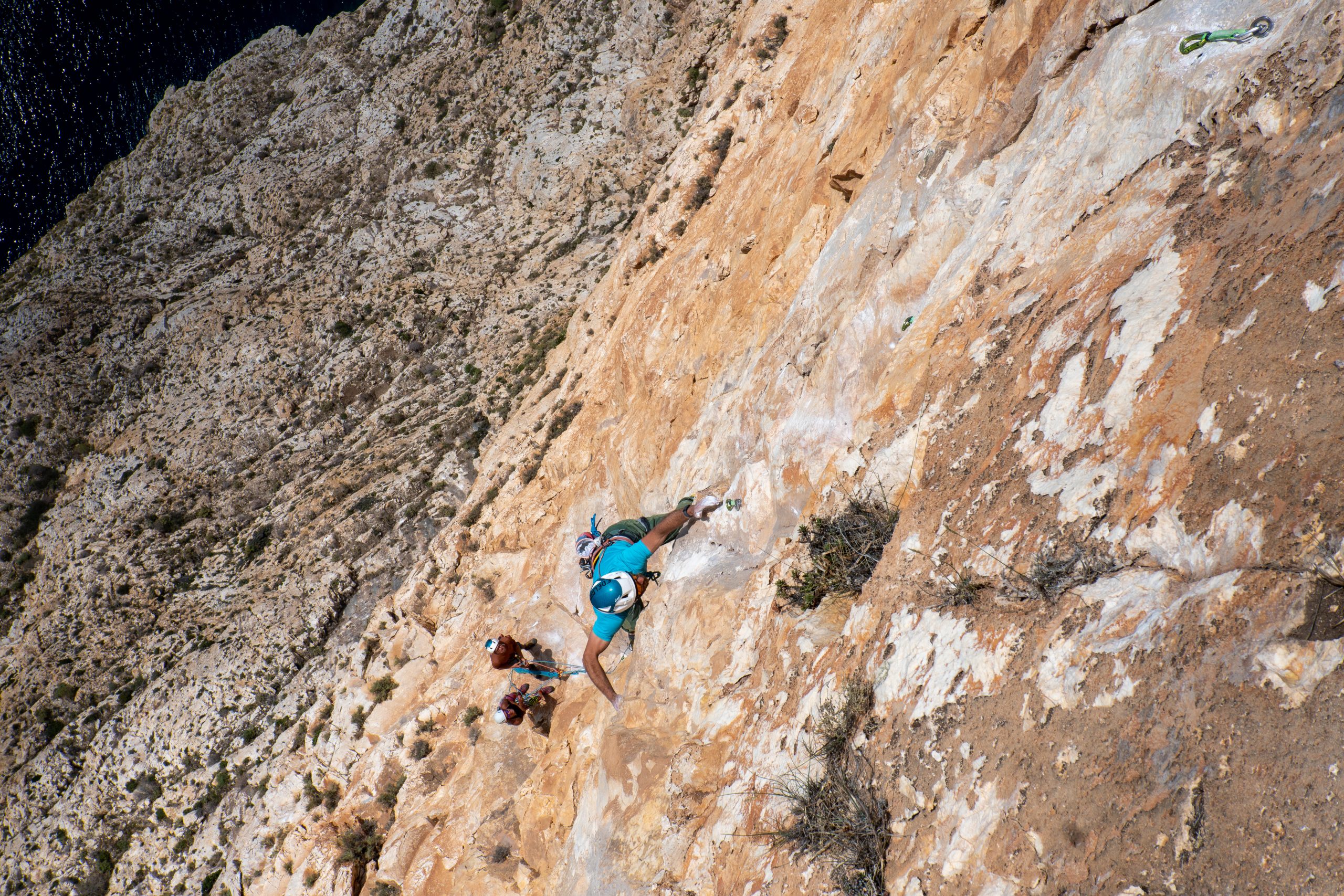

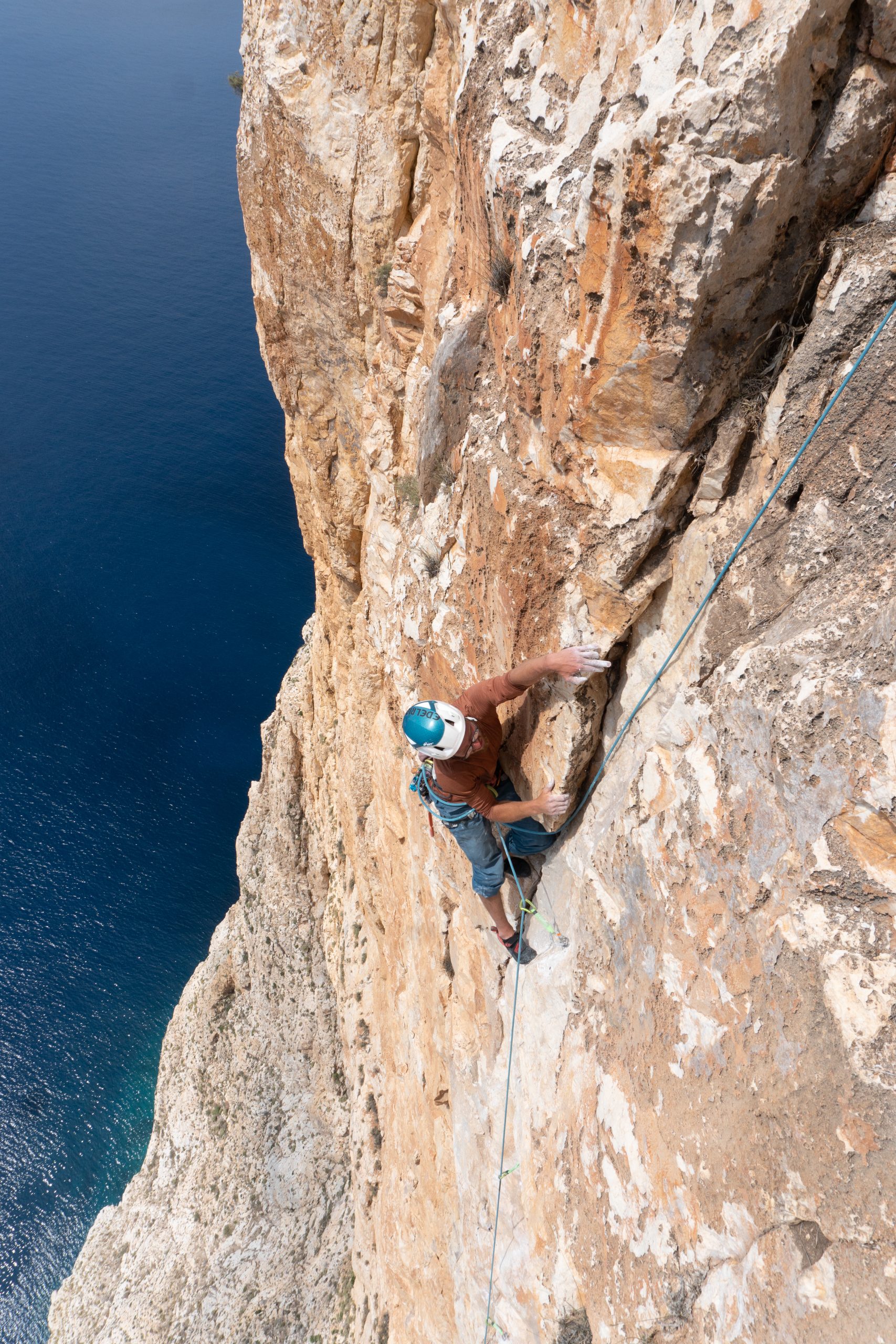
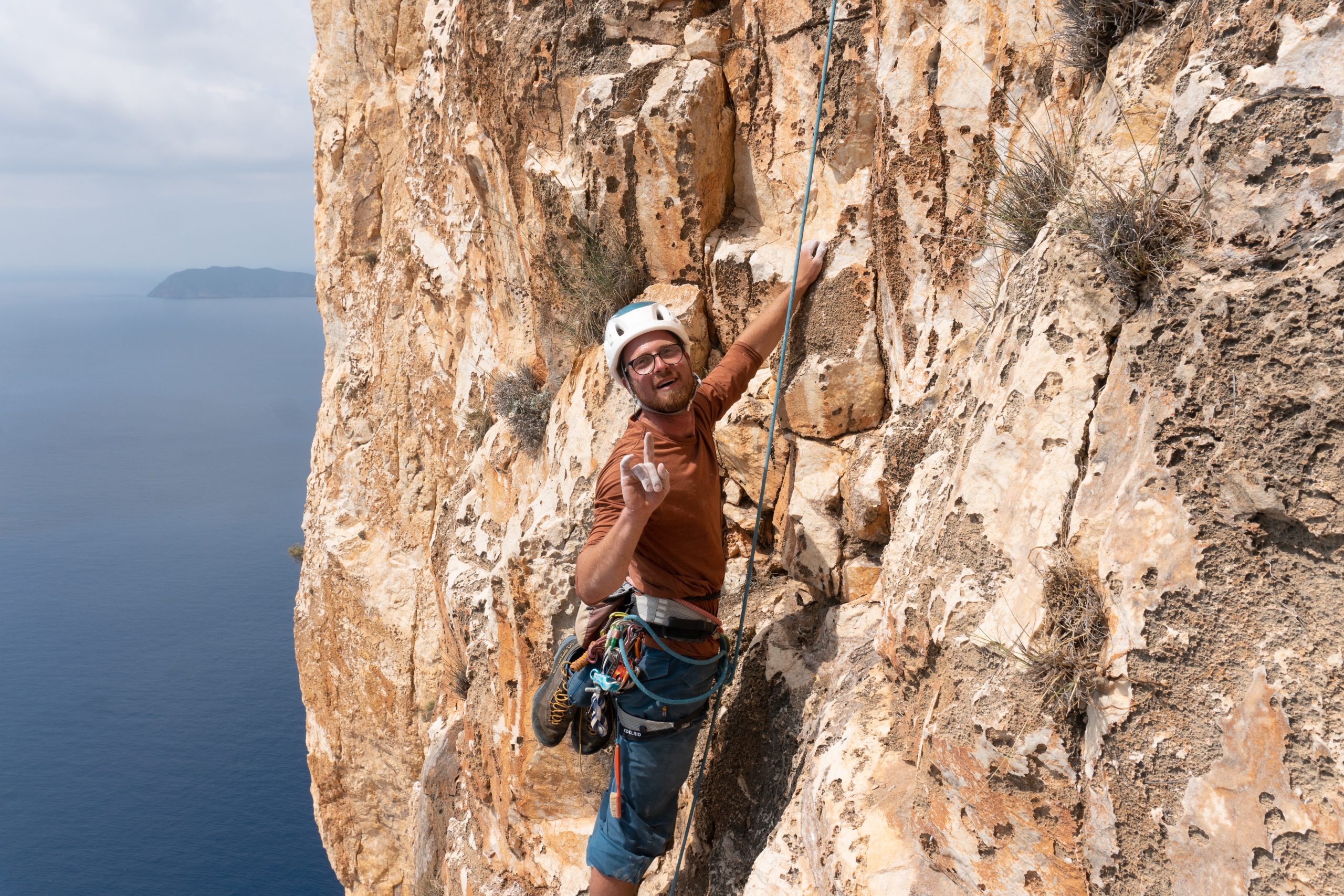
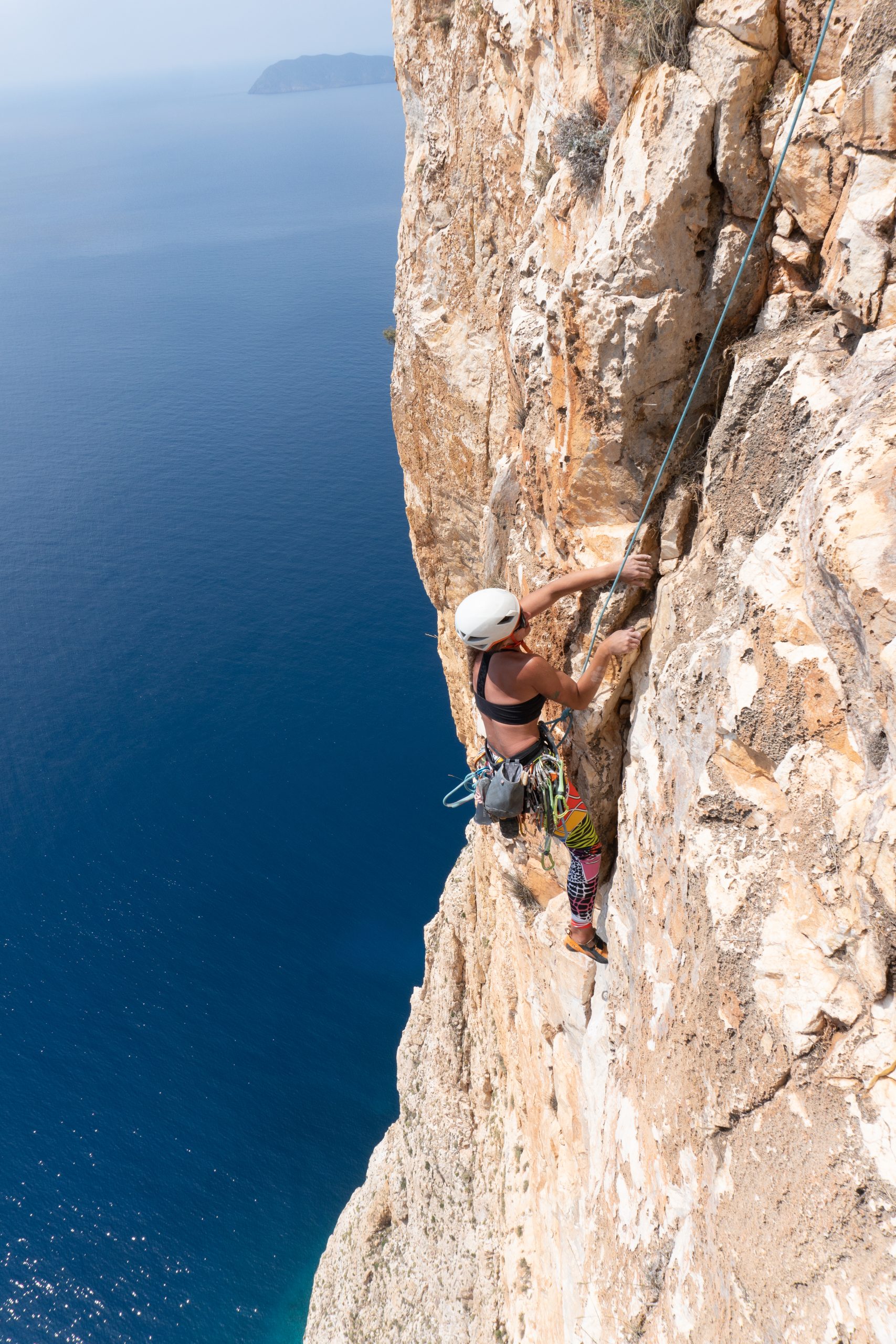

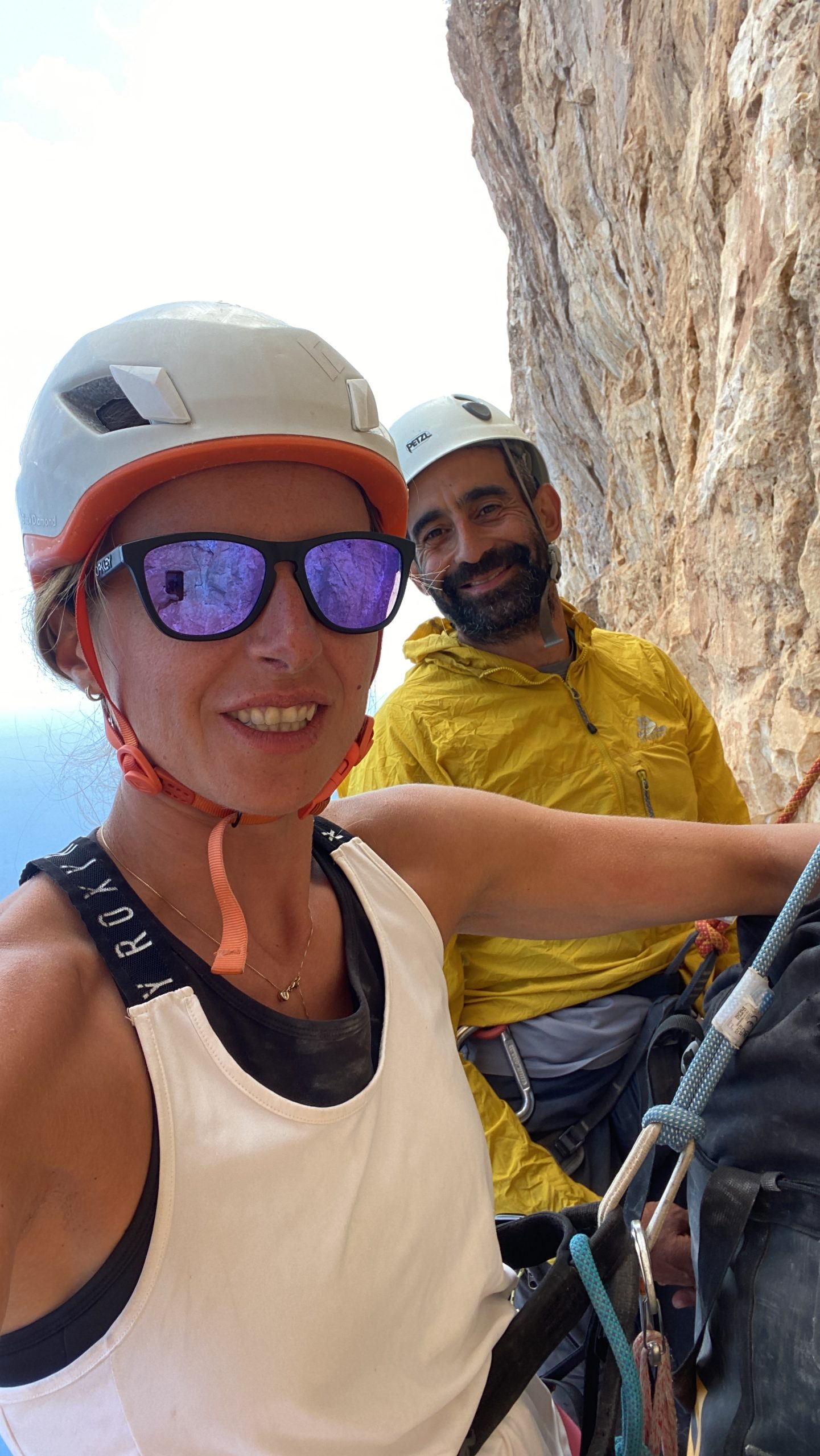

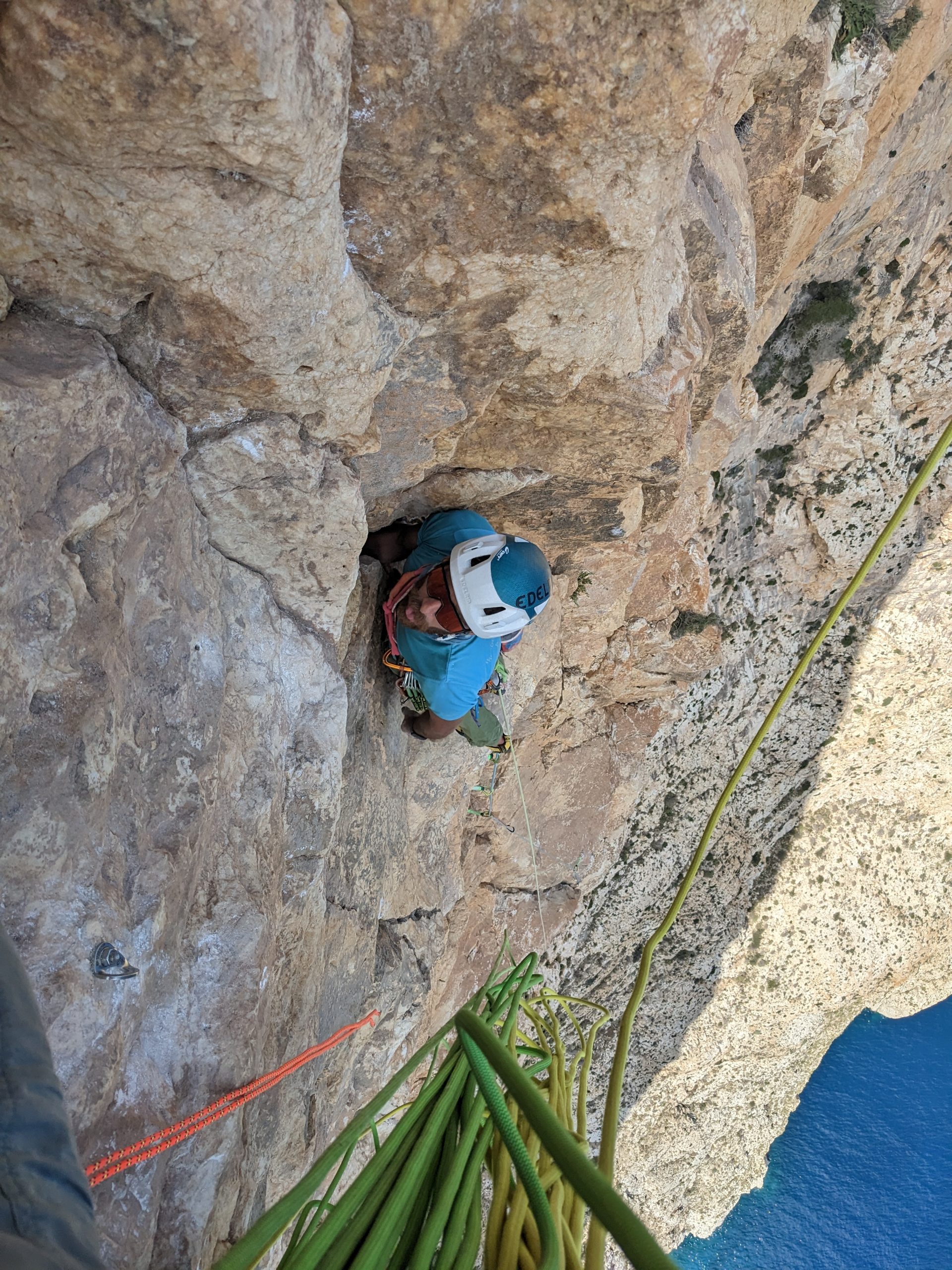
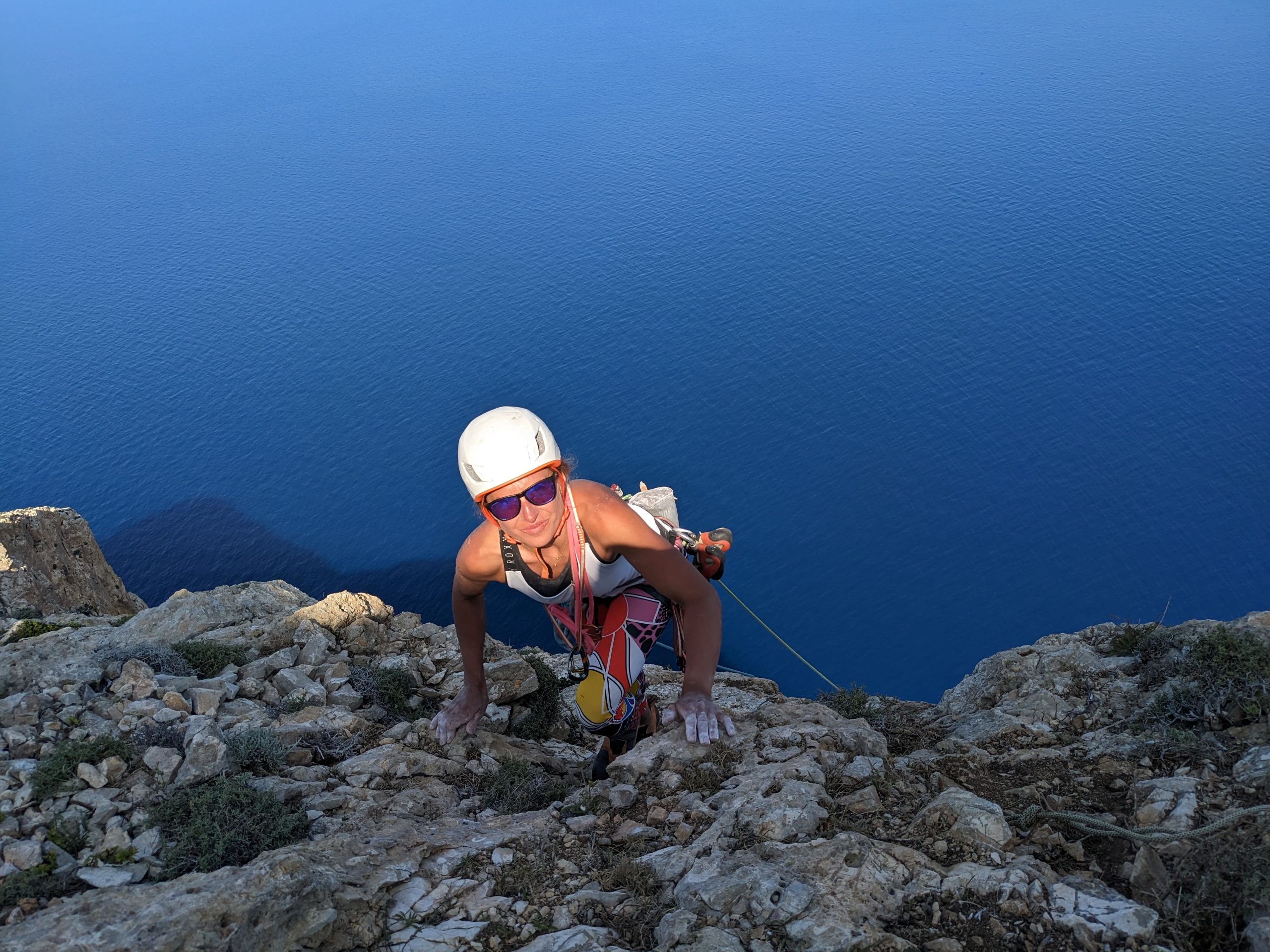


Topo
The Ritual of Hardship 7b(6c obl.)
500m 19 pitches
Bolted where necessary plus all belays with lappasclimbingbolts, a full rack of cams up to #3 plus wires needed.
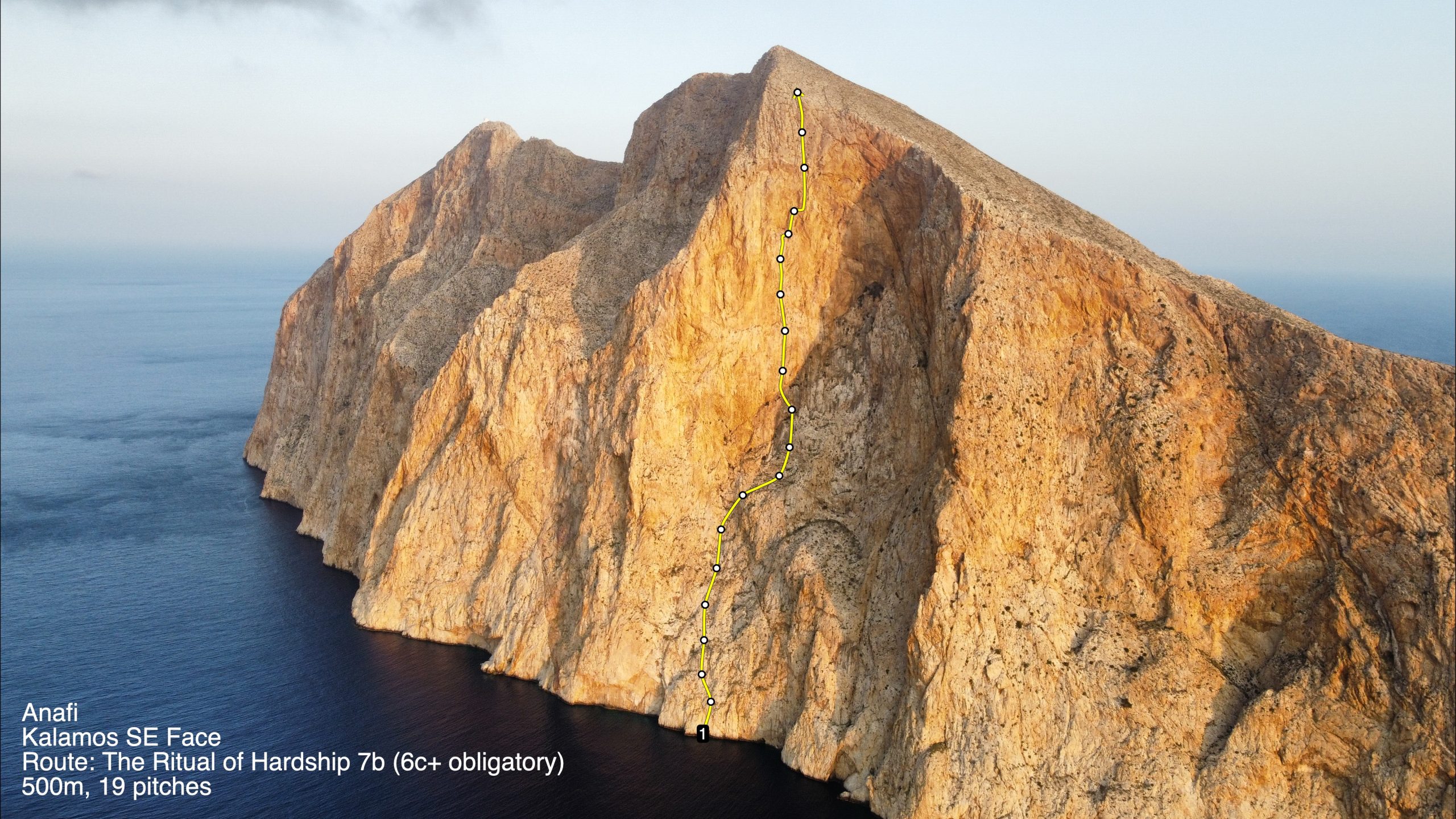
- 4 15m. Starting on a ledge 5m above the water follow the obvious crack straight above.
- 3 20m. Follow the diagonal ramp to the left. 1 bolt.
- 5b 20m. 4 bolts
- 5a 22m. 4 bolts
- 5a 42m. Navigate in between the steep dirt ledges following the rocky parts.
- 5b 20m. 3 bolts
- 5c 20m. Follow the steep ramp to the right with some short overhang sections. 5 bolts
- 3 10m. Traverse right to the Mouse Ledge. 3 bolts
- 5a 37m. Start to the right of the belay and then traverse back left.
- 6a+ 38m. Follow slabby terrain to the start of the orange rock and climb that to a belay in a crystal oven hole. 10 bolts
- 6c+/7a 28m. Traverse left from the belay and then straight up the steep face climb o crimps. Then traverse left to gain the base of the steep crystal oven crack and follow it to a belay on the top right. 11 bolts
- 6c+/7a 28m. Follow the cracks straight above the belay that lead you to some technical climbing. Belay on the left. 8 bolts.
- 6b 32m. Steep juggy terrain straight above the belay and then left and follow the corner to the belay on a good ledge. 6 bolts.
- 6b+ 27m. To the right of the belay up steep ledges and overhangs. 6 bolts.
- 7b 32m. Follow the corner system to a steep pocketed wall and then traverse left to another corner system. Bellay on the Party Ledge. 11 bolts.
- 6a+ 16m. Starting at the belay on the right side of the ledge follow the vertical ramp up and right to a ledge belay. 6 bolts.
- 6c+/7a 36m. Traverse to the right of the ledge and follow the narrowing corner up and right. Then on a vertical wall with some overhang passages. 6 bolts.
- 6c 36m. Follow the steep crack right above the belay and then on easier terrain. 7 bolts.
- 6a 24m. Gray slap with pockets. 5 bolts.
Note: the grades suggested here are really subjective. We cleaned most of the loose rocks especially on the headwall pitches while bolting however, we only cleaned holds and figured out the beta on our first climbing attempts.
Special thanks to Get Out and Edelrid who provided some top-end gear and also lent us the portaledge for our adventure.

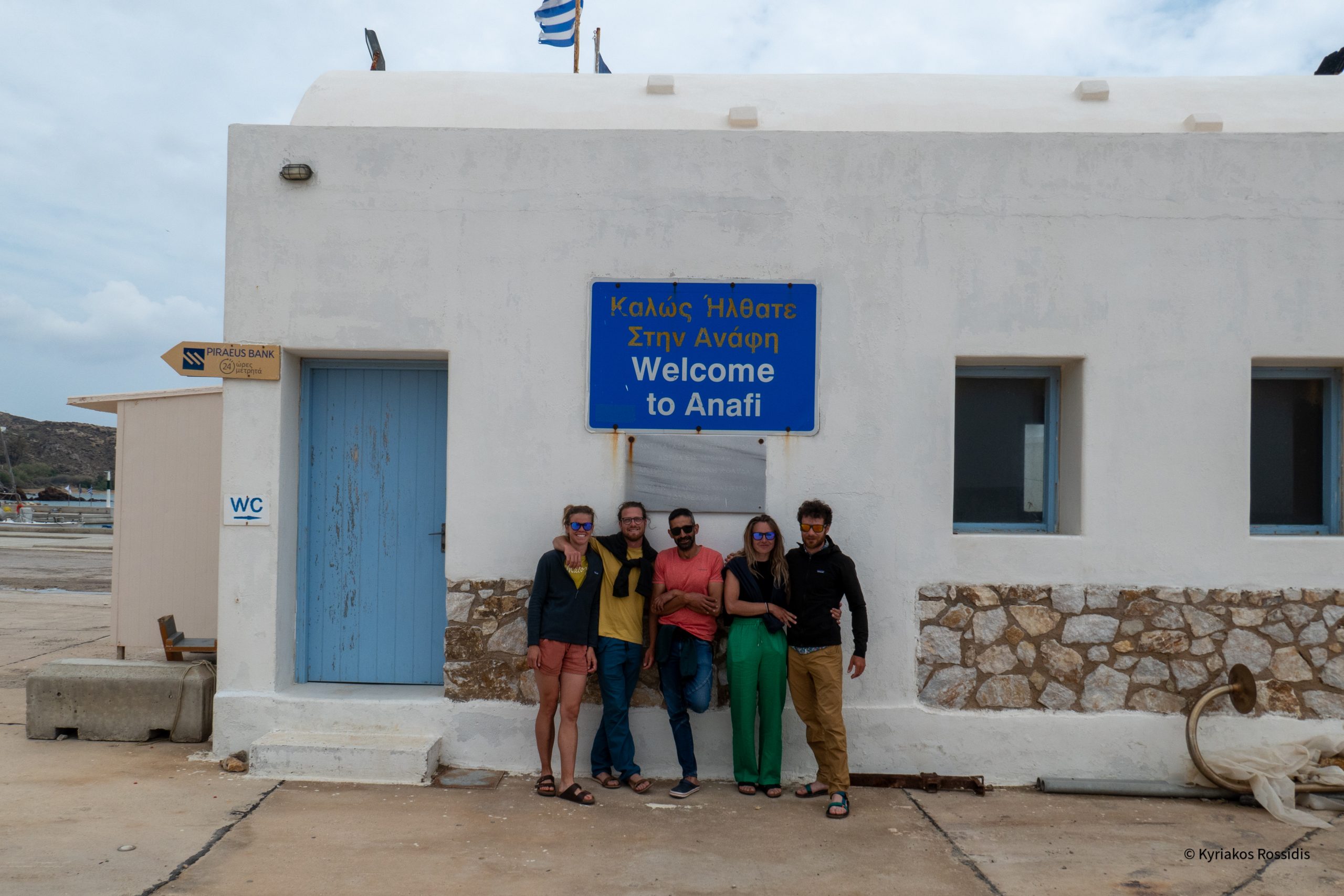
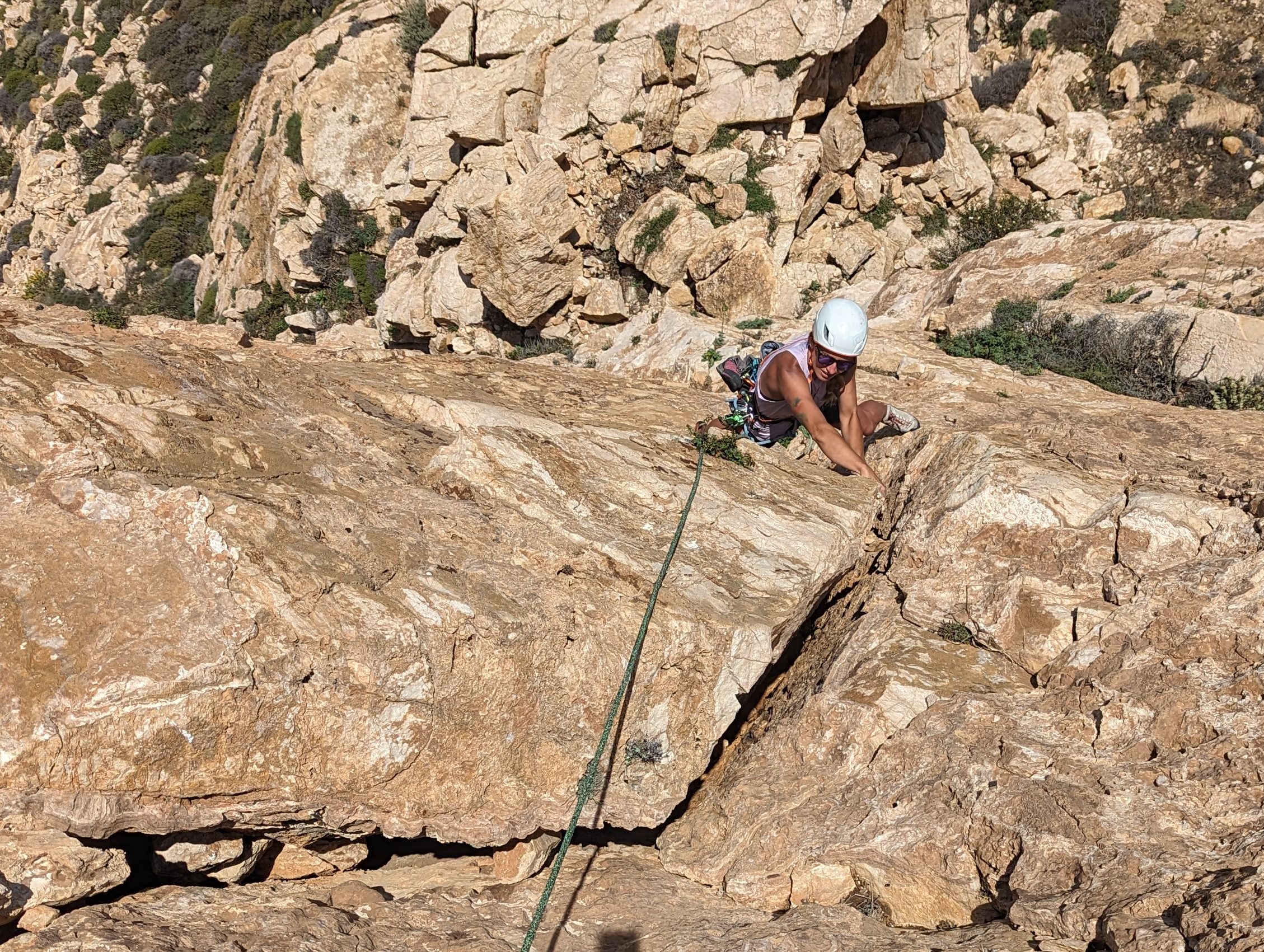

Leave a Reply